#j. l. berg
Explore tagged Tumblr posts
Text
🔬🌀Demystifying the Krebs Cycle: A Deep Dive into Cellular Respiration! 🌀🔬
Prepare for a thrilling journey into the heart of cellular metabolism! 🌟✨ Today, we unravel the intricacies of the Krebs Cycle, also known as the Citric Acid Cycle or Tricarboxylic Acid Cycle, a cornerstone of energy production in our cells. 💡🤯
The Krebs Cycle: Named after its discoverer, Sir Hans Krebs, this metabolic pathway occurs within the mitochondria and is a central hub in cellular respiration.
🔍Step 1: Acetyl-CoA Entry
Acetyl-CoA, derived from the breakdown of glucose or fatty acids, enters the cycle.
It combines with oxaloacetate to form citrate, a six-carbon compound.
🔍Step 2: Isocitrate Formation
A rearrangement converts citrate into isocitrate.
The enzyme aconitase facilitates this transformation.
🔍Step 3: Alpha-Ketoglutarate Production
Isocitrate undergoes oxidative decarboxylation, shedding a CO2 molecule and yielding alpha-ketoglutarate.
NAD+ is reduced to NADH in this step.
🔍Step 4: Succinyl-CoA Synthesis
Alpha-ketoglutarate loses CO2 and acquires a CoA group to form succinyl-CoA.
Another NAD+ is reduced to NADH.
This step is catalyzed by alpha-ketoglutarate dehydrogenase.
🔍Step 5: Succinate Formation
Succinyl-CoA releases CoA, becoming succinate.
A molecule of GTP (guanosine triphosphate) is generated as a high-energy phosphate bond.
Succinate dehydrogenase is pivotal, transferring electrons to the electron transport chain (ETC).
🔍Step 6: Fumarate Generation
Succinate is oxidized to fumarate with the help of the enzyme succinate dehydrogenase.
FADH2 (flavin adenine dinucleotide) is formed and transfers electrons to the ETC.
🔍Step 7: Malate Formation
Fumarate undergoes hydration to form malate, catalyzed by fumarase.
🔍Step 8: Regeneration of Oxaloacetate
Malate is oxidized back to oxaloacetate.
NAD+ is reduced to NADH.
Oxaloacetate is ready to initiate another round of the Krebs Cycle.
The Krebs Cycle - an intricate dance of chemical transformations fueling the cellular machinery of life. 🕺💃 Dive deeper into cellular respiration, where molecules tango to generate ATP, our cellular energy currency!

📚References for In-Depth Exploration📚
Berg, J. M., Tymoczko, J. L., & Stryer, L. (2002). Biochemistry (5th ed.). W. H. Freeman. Chapter 17.
Voet, D., Voet, J. G., & Pratt, C. W. (2008). Fundamentals of Biochemistry (3rd ed.). John Wiley & Sons. Chapter 17.
Lehninger, A. L., Nelson, D. L., & Cox, M. M. (2008). Lehninger Principles of Biochemistry (5th ed.). W. H. Freeman. Chapter 17.
#science#biology#college#education#school#student#medicine#doctors#health#healthcare#biochemistry#cell#science nerds
115 notes
·
View notes
Text
GROVER CLEVELAND •Grover Cleveland: A Study In Courage by Allan Nevins (BOOK) •An Honest President: The Life and Presidencies of Grover Cleveland by H. Paul Jeffers (BOOK | AUDIO) •A Secret Life: The Lies and Scandals of President Grover Cleveland by Charles Lachman (BOOK | KINDLE | AUDIO) •A Man of Iron: The Turbulent Life and Improbable Presidency of Grover Cleveland by Troy Senik (BOOK | KINDLE | AUDIO)
BENJAMIN HARRISON •Benjamin Harrison: Hoosier Warrior, 1833-1865 by Harry J. Sievers (BOOK) •Benjamin Harrison: Hoosier Statesman, 1865-1888 by Harry J. Sievers (BOOK) •Benjamin Harrison: Hoosier President, 1889-1893 by Harry J. Sievers (BOOK)
WILLIAM McKINLEY •In the Days of McKinley by Margaret Leech (BOOK) •President McKinley: Architect of the American Century by Robert W. Merry (BOOK | KINDLE) •William McKinley and His America by H. Wayne Morgan (BOOK | KINDLE) •The Triumph of William McKinley: Why the Election of 1896 Still Matters by Karl Rove (BOOK | KINDLE | AUDIO)
THEODORE ROOSEVELT •The Rise of Theodore Roosevelt by Edmund Morris (BOOK | KINDLE | AUDIO) •Theodore Rex by Edmund Morris (BOOK | KINDLE | AUDIO) •Colonel Roosevelt by Edmund Morris (BOOK | KINDLE | AUDIO) •Edmund Morris Trilogy •The River of Doubt: Theodore Roosevelt's Darkest Journey by Candice Millard (BOOK | KINDLE | AUDIO) •Mornings On Horseback: The Story of an Extraordinary Family, a Vanished Way of Life, and the Unique Child Who Became Theodore Roosevelt by David McCullough (BOOK | KINDLE | AUDIO) •T.R.: The Last Romantic by H.W. Brands (BOOK | KINDLE | AUDIO)
WILLIAM HOWARD TAFT •The Bully Pulpit: Theodore Roosevelt, William Howard Taft, and the Golden Age of Journalism by Doris Kearns Goodwin (BOOK | KINDLE | AUDIO) •William Howard Taft: An Intimate History by Judith Icke Anderson (BOOK) •Chief Executive to Chief Justice: Taft Betwixt the White House and Supreme Court by Lewis L. Gould (BOOK | KINDLE)
WOODROW WILSON •Wilson by A. Scott Berg (BOOK | KINDLE | AUDIO) •Woodrow Wilson: A Biography by John Milton Cooper Jr. (BOOK | KINDLE | AUDIO) •When the Cheering Stopped: The Last Years of Woodrow Wilson by Gene Smith (BOOK | KINDLE) •The Ordeal of Woodrow Wilson by Herbert Hoover (BOOK) •The Moralist: Woodrow Wilson and the World He Made by Patricia O'Toole (BOOK | KINDLE | AUDIO)
WARREN G. HARDING •The Shadow of Blooming Grove: Warren G. Harding in His Times by Francis Russell (BOOK) •The Available Man: The Life Behind the Masks of Warren G. Harding by Andrew Sinclair (BOOK) •1920: The Year of the Six Presidents by David Pietrusza (BOOK | KINDLE | AUDIO) •The Ohio Gang: The World of Warren G. Harding by Charles L. Mee Jr. (BOOK | KINDLE)
CALVIN COOLIDGE •Coolidge by Amity Shlaes (BOOK | KINDLE | AUDIO) •The High Tide of American Conservatism: Davis, Coolidge, and the 1924 Election by Garland S. Tucker III (BOOK | KINDLE)
#Books#Book Suggestions#Book Recommendations#Books About Presidents#Presidents#Presidency#Presidents Books#Presidential Books#Grover Cleveland#President Cleveland#Cleveland Administration#Benjamin Harrison#President Harrison#Harrison Administration#William McKinley#President McKinley#McKinley Administration#Assassination of William McKinley#McKinley Assassination#Theodore Roosevelt#President Roosevelt#Roosevelt Administration#TR#William Howard Taft#President Taft#Taft Administration#Woodrow Wilson#President Wilson#Wilson Administration#Warren G. Harding
34 notes
·
View notes
Text

My Top 10 Favorite 20th Century Fox Movies (2024)
#10 Home Alone
#9 Ice Age
#8 Ice Age 2: The Meltdown
#7 Ice Age 3: Dawn Of The Dinosaurs
#6 Ice Age 4: Continental Drift
#5 The Peanuts Movie
#4 Spies In Disguise
#3 Alvin And The Chipmunks (2007)
#2 Family Guy: Stewie Griffin: The Untold Story
And #1 The Simpsons Movie
Original Template: https://www.deviantart.com/jackskellington416/art/Top-10-20th-Century-Fox-Films-Meme-665656007
Home Alone Belongs To John Hughes, Hughes Entertainment, 20th Century Studios, Inc. The Walt Disney Studios, Walt Disney Studios Motion Pictures, Disney Entertainment, And The Walt Disney Company
Ice Age (2002 film) Belongs to Michael Berg, Michael J. Wilson, Peter Ackerman, Blue Sky Studios, Inc. 20th Century Animation, 20th Century Studios, Inc. The Walt Disney Studios, Walt Disney Studios Motion Pictures, Disney Entertainment, And The Walt Disney Company
Ice Age 3: Dawn of the Dinosaurs Belongs to Michael Berg, Peter Ackerman, Mike Reiss, Yoni Brenner, Blue Sky Studios, Inc. 20th Century Animation, 20th Century Studios, Inc. The Walt Disney Studios, Walt Disney Studios Motion Pictures, Disney Entertainment, And The Walt Disney Company
Ice Age 4: Continental Drift Belongs to Michael Berg, Jason Fuchs, Blue Sky Studios, Inc. 20th Century Animation, 20th Century Studios, Inc. The Walt Disney Studios, Walt Disney Studios Motion Pictures, Disney Entertainment, And The Walt Disney Company
The Peanuts Movie Belongs To Charles M. Schulz, Craig Schulz, Bryan Schulz, Cornelius Uliano, United Feature Syndicate, Inc. Andrews McMeel Syndication, Blue Sky Studios, Inc. 20th Century Animation, 20th Century Studios, Inc. The Walt Disney Studios, Walt Disney Studios Motion Pictures, Disney Entertainment, And The Walt Disney Company
Spies In Disguise Belongs To Lucas Martell, Brad Copeland, Lloyd Taylor, Cindy Davis, Chernin Entertainment, Blue Sky Studios, Inc. 20th Century Animation, 20th Century Studios, Inc. The Walt Disney Studios, Walt Disney Studios Motion Pictures, Disney Entertainment, And The Walt Disney Company
Alvin And The Chipmunks (2007) Belongs To Ross Bagdasarian Sr. Jon Vitti, Will McRobb, Chris Viscardi, Bagdasarian Productions, Dune Entertainment, RatPac Entertainment, LLC, Monarchy Enterprises S.Á.R.L. Regency Entertainment (USA), Inc. FOX 2000 Pictures, 20th Century Studios, Inc. The Walt Disney Studios, Walt Disney Studios Motion Pictures, Disney Entertainment, And The Walt Disney Company
Family Guy: Stewie Griffin: The Untold Story Belongs To Seth MacFarlane, Gary Janetti, Chris Sheridan, Alex Borstein, Steve Callaghan, Sunwoo & Company Co., Ltd. Fuzzy Door Productions, Inc. 20th Television Animation, 20th Television, 20th Century Fox Home Entertainment, Buena Vista Home Entertainment, Inc. Walt Disney Studios Home Entertainment, Disney Platform Distribution, Inc. Disney Television Studios, Disney General Entertainment Content, Disney Entertainment, FOX Broadcasting Company, FOX Entertainment, FOX Corporation, And The Walt Disney Company
The Simpsons Movie Belongs To James L. Brooks, Matt Groening, Al Jean, Ian Maxtone-Graham, George Meyer, David Mirkin, Mike Reiss, Mike Scully, Matt Selman, John Swartzwelder, Jon Vitti, Film Roman, LLC, Rough Draft Studios, Inc. AKOM Production Ltd. Gracie Films, 20th Century Animation, 20th Century Studios, Inc. The Walt Disney Studios, Walt Disney Studios Motion Pictures, Disney Entertainment, And The Walt Disney Company
2 notes
·
View notes
Text
Interesting Papers for Week 17, 2023
Oversampled and undersolved: Depressive rumination from an active inference perspective. Berg, M., Feldmann, M., Kirchner, L., & Kube, T. (2022). Neuroscience & Biobehavioral Reviews, 142, 104873.
Orbitofrontal cortex populations are differentially recruited to support actions. Cazares, C., Schreiner, D. C., Valencia, M. L., & Gremel, C. M. (2022). Current Biology, 32(21), 4675-4687.e5.
Causality modulates perception of apparent motion stimuli. Deeb, A.-R., Silva, A. E., & Liu, Z. (2022). Vision Research, 201, 108120.
Energy-efficient network activity from disparate circuit parameters. Deistler, M., Macke, J. H., & Gonçalves, P. J. (2022). Proceedings of the National Academy of Sciences, 119(44), e2207632119.
A direct test of competitive versus cooperative episodic–procedural network dynamics in human memory. Freedberg, M. V, Reeves, J. A., Fioriti, C. M., Murillo, J., Voss, J. L., & Wassermann, E. M. (2022). Cerebral Cortex, 32(21), 4715–4732.
Perceived speed at low luminance: Lights out for the Bayesian observer? Freeman, T. C. A., & Powell, G. (2022). Vision Research, 201, 108124.
Neuronal signature of spatial decision-making during navigation by freely moving rats by using calcium imaging. Gobbo, F., Mitchell-Heggs, R., Tse, D., Al Omrani, M., Spooner, P. A., Schultz, S. R., & Morris, R. G. M. (2022). Proceedings of the National Academy of Sciences, 119(44), e2212152119.
Cross-modal generalization of value-based attentional priority. Grégoire, L., Mrkonja, L., & Anderson, B. A. (2022). Attention, Perception, & Psychophysics, 84(8), 2423–2431.
Development of information integration in the visual working memory of preschoolers. Guo, D., Wang, Y., Liao, Y., Li, J., Zhang, X., Gao, Z., … He, J. (2022). Child Development, 93(6), 1793–1803.
Mapping neurotransmitter systems to the structural and functional organization of the human neocortex. Hansen, J. Y., Shafiei, G., Markello, R. D., Smart, K., Cox, S. M. L., Nørgaard, M., … Misic, B. (2022). Nature Neuroscience, 25(11), 1569–1581.
Information‐seeking when information doesn’t matter. Hilchey, M. D., Rondina, R., & Soman, D. (2022). Journal of Behavioral Decision Making, 35(5), e2280.
Dual-polarity voltage imaging of the concurrent dynamics of multiple neuron types. Kannan, M., Vasan, G., Haziza, S., Huang, C., Chrapkiewicz, R., Luo, J., … Pieribone, V. A. (2022). Science, 378(6619).
Recursive sequence generation in crows. Liao, D. A., Brecht, K. F., Johnston, M., & Nieder, A. (2022). Science Advances, 8(44).
Flexible neural control of motor units. Marshall, N. J., Glaser, J. I., Trautmann, E. M., Amematsro, E. A., Perkins, S. M., Shadlen, M. N., … Churchland, M. M. (2022). Nature Neuroscience, 25(11), 1492–1504.
Adult-born dentate granule cells promote hippocampal population sparsity. McHugh, S. B., Lopes-dos-Santos, V., Gava, G. P., Hartwich, K., Tam, S. K. E., Bannerman, D. M., & Dupret, D. (2022). Nature Neuroscience, 25(11), 1481–1491.
Rapid encoding of task regularities in the human hippocampus guides sensorimotor timing. Polti, I., Nau, M., Kaplan, R., van Wassenhove, V., & Doeller, C. F. (2022). eLife, 11, e79027.
Task-specific employment of sensory signals underlies rapid task switching. Sasaki, R., Kumano, H., Mitani, A., Suda, Y., & Uka, T. (2022). Cerebral Cortex, 32(21), 4657–4670.
Differential coding of absolute and relative aversive value in the Drosophila brain. Villar, M. E., Pavão-Delgado, M., Amigo, M., Jacob, P. F., Merabet, N., Pinot, A., … Perisse, E. (2022). Current Biology, 32(21), 4576-4592.e5.
Behavioural and dopaminergic signatures of resilience. Willmore, L., Cameron, C., Yang, J., Witten, I. B., & Falkner, A. L. (2022). Nature, 611(7934), 124–132.
How much I moved: Robust biases in self-rotation perception. Zanchi, S., Cuturi, L. F., Sandini, G., & Gori, M. (2022). Attention, Perception, & Psychophysics, 84(8), 2670–2683.
#science#Neuroscience#computational neuroscience#Brain science#research#cognition#neurons#neurobiology#neural networks#neural computation#cognitive science#psychophysics#scientific publications
19 notes
·
View notes
Photo

“Le canal Lachine doit être vidé le 20 de ce mois,” La Presse. March 10, 1933. Page 8. ---- On y effectuera les réparations nécessaires pour as- surer l'étanchéité du tunnel. ---- Assemblée maritime ---- Si les conditions de la température le permettent, il est plus que probable que le canal Lachine sera vidé vers le 20 courant pour y entreprendre les réparations nécessaires à ses berges. Les travaux seront effectués dans un temps assez rapide pour donner passage aux vaisseaux vers le 24 avril. Le canal sera, toutefois, rempli à nouveau vers le 20. Un examen très sévère sera fait à l'endroit o�� se produisit, l'an dernier, presqu'à la même époque une première fissure par laquelle l'eau pénétra pour inonder Ia partie inférieure du tunnel de la rue Wellington. Comme on le sait, les travaux furent alors suspendus afin de permettre à la compagnie de retirer l'eau et continuer ses travaux. Dès que le canal sera complètement vidé, des experts sonderont le lit et les parois du canal pour bien s'assurer s'il existe des lézardes. Le tunnel de la rue Wellington sera complètement parachevé vers la fin de ce mols et toutes les précautions seront prises par le ministère des chemins de fer et canaux pour en assurer l'étanchéité.
Pour la prochaine saison Les représentants des différentes compagnies maritimes y compris l'Associated Lake Freighters, Limited, ont été en assemblée pendant deux jours à l'hôtel Mont-Royal en vue d'étudier les préparatifs pour Ia prochaine saison de navigation sur les grands lacs et le fleuve Saint-Laurent. Interviewé hier soir, M. Arthur Mathewson, de Montréal, président de l'organisation, a expliqué que les délibérations avalent été très satisfaisantes ayant eu trait tout particulièrement aux avantages mutuels des divers, propriétaires de navires. Il a ajouté être convaincu que l'Associated Lake Freighters, Limited, sera en meilleure position, la saison prochaine, de donner un service adéquat aux expéditeurs et aux propriétaires de navires. Sous ce rapport, il a rendu hommage à M. James Stewart, gérant de l'organisation avec quartiers généraux à Winnipeg. En plus de M. Mathewson, on remarquait: MM. T.-R. Enderby, vice-président, de Montréal; R.-A. Carter, secrétaire-trésorier; le capitaine H-I. Beauvals, le capitaine Léon Beaupré, J.-D. Calvin, P. Godin, fils; T. Siegerman, E. Spence et le capitaine T-W. Tinmouth, tous de Montréal. MM. A.-B. Buckworth et le capitaine James-B. Foote, de Toronto: le capitaine Scott Misener, de Port Colborne: J-J. Boland, E.-S. Crosby et E-T. Douglas, de Buffalo, N-Y, Norman M. Paterson, de Fort William, et L. Wolvin, de Winnipeg. M. Mathewson a laissé entendre que le taux du transport du grain entre Fort William, Port Arthur et Mont- réal à l'ouverture de la navigation sera de 6 centins et demi le boisseau, bien que ce taux eût été décide à Winnipeg avant l'assemblée tenue ici.
#montreal#lachine#lachine canal#infrastructure project#infrastructure maintenance#freighter#lakers#shipping company#shipping news#navigation season#great depression in canada
4 notes
·
View notes
Text
My 2023 Reading List
Here's the books and articles that I read in 2023 (a large part of which was a push to finish my dissertation). I thought it might also be useful to others to see what my workload looks like as a 7th year grad student in a PhD. program, especially since I'm unmedicated with severe ADHD. This is what I'm able to get done while fighting through that. I bring this up because I know that it can seem fucking impossible, most notably when we see our neurotypical colleagues churning through incredible amounts of research. A final note: two of the books I'm including in here are books that I started reading in 2022 (Kagan and Stock). Also, note that many of these are re-reads; I've marked these with an Asterisk, and a couple of the books I read around 90%, but dropped a couple chapters that weren't relevant for my projects. These are marked with two asterisks. Be aware that my citations here are of a pretty rough and ready style. Philosophy has weird disciplinary standards (read, almost every journal is different), so I just have a "here's what you need to know to find it" style here. CW: I work on some dark things involving death, suicide, sexual assault, sex, race, and trans rights, including actively fighting trans-exclusive theorists, so there's a lot of possibly triggering things in here.
Updated: Jan 4, 2024
Abdollah, Serajian, Ebrahim Khosrow, and Sajad Ahmadizad. 2014. “Comparison of Anthropometric and Functional Characteristics of Elite Male Iranian Fencers in Three Weapons.” International Journal of Applied Sport Sciences 26 (1): 11–17.
Alcoff, Linda. 1991. “The Problem of Speaking for Others.” Cultural Critique No. 20 5–32.
Alcoff, Linda. 2007. “Epistemologies of Ignorance: Three Types.” In Race and Epistemologies of Ignorance, edited by Shannon and Tuana Sullivan, Nancy, 39–50. Albany: State University of New York Press.
Anderson, Elizabeth. 2012. “Epistemic Justice as a Virtue of Social Institutions.” Social Epistemology 26 (2): 163–73.
Andler, Matthew. 2017. “Gender Identity and Exclusion: A Reply to Jenkins.” Ethics
Ashley, Florence. 2023. “What is it Like to Have a Gender Identity.” Mind 132 (528): 1053–73.
Ballantyne, Nathan. 2019. “Epistemic Trespassing.” Mind 128 (510): 367–95.
Ballantyne, Nathan, Jared Celniker, and David Dunning. 2022. “Do Your Own Research.” Social Epistemology
Barnett, Brian S, Ariana E Nesbit, and Reneé M Sorrentino. 2018. “The Transgender Bathroom Debate At the Intersection of Politics, Law, Ethics, and Science.” J Am Acad Psychiatry Law 46 (2): 232–41.*
Berg, Amy. 2022. “Is There a Duty to Read the News.” Journal of Moral Philosophy 20 (3-4): 243–67.
Bergero-Miguel, Trinidad, María A García-Encinas, Amelia Villena-Jimena, Lucía Pérez-Costillas, Nicolás Sánchez-Álvarez, Yolanda de Diego-Otero, and Jose Guzman-Parra. 2016. “Gender Dysphoria and Social Anxiety: An Exploratory Study in Spain.” J Sex Med 13 (8): 1270–78.*
Bettcher, Talia Mae. 2009. “Trans Identities and First-Person Authority.” In You’Ve Changed: Sex Reassignment and Personal Identity, edited by Laurie Shrage, 98–120. Oxford University Press.*
Biggs, Michael. Suicide By Trans-Identified Children in England and Wales. Transgender Trend.*
Blair, Karen L., and Rhea Ashley Hoskin. 2019. “Transgender Exclusion From the World of Dating: Patterns of Acceptance and Rejection of Hypothetical Trans Dating Partners as a Function of Sexual and Gender Identity.” Journal of Social and Personal Relationships 36 (7): 2074–95.
Blanchard, Matt, and Barry Farber. 2016. “Lying in Psychotherapy: Why and What Clients Don’t Tell Their Therapist About Therapy and Their Relationship.” Counselling Psychology Quarterly 29 (1): 90–112.
Blanchard, Matt, and Barry Farber. 2020. “”It is Never Okay to Talk About Suicide”: Patients’ Reasons for Concealing Suicidal Ideation in Psychotherapy.” Psychother Res 30 (1): 124–36.
Bochicchio, Lauren, Kelsey Reeder, Lauren Aronson, Charles McTavish, and Ana Stefancic. 2021. “Understanding Factors Associated With Suicidality Among Transgender and Gender-Diverse Identified Youth.” LGBT Health 8 (4): 245–53.
Bradley, Ben. 2012. “Doing Away With Harm.” Philosophy and Phenomenological Research 85, No. 2 390–412.*
Brown, Brookes. 2023. “Bearing Witness: The Duty of Non‐indifference and the Case for Reading the News.” Pacific Philosophical Quarterly 104 (2): 368–91.
Bustos, Valeria P, Samyd S Bustos, Andres Mascaro, Gabriel Del Corral, Antonio J Forte, Pedro Ciudad, Esther A Kim, Howard N Langstein, and Oscar J Manrique. 2021. “Regret After Gender-Affirmation Surgery: A Systematic Review and Meta-Analysis of Prevalence.” Plast Reconstr Surg Glob Open 9 (3): e3477.*
Byrne, Alex. 2020. “Are Women Adult Human Females.” Philosophical Studies 177 (12): 3783–803.
Carel, Havi, and Ian Kidd. 2014. “Epistemic Injustice in Healthcare: A Philosophical Analysis.” Med Health Care Philos 17 (4): 529–40.
Cattien, Jana. 2019. “Against “Transracialism”: Revisiting the Debate.” Hypatia 34 (4): 713–35.
Clements-Nolle, Kristen, Rani Marx, and Mitchell Katz. 2006. “Attempted Suicide Among Transgender Persons: The Influence of Gender-Based Discrimination and Victimization.” Journal of Homosexuality 51 (3): 53–69.*
Congdon, Matthew. 2018. ““Knower” as an Ethical Concept: From Epistemic Agency to Mutual Recognition.” Feminist Philosophy Quarterly 4 (4):
Costa, Rosalia, and Marco Colizzi. 2016. “The Effect of Cross-Sex Hormonal Treatment on Gender Dysphoria Individuals’ Mental Health: A Systematic Review.” Neuropsychiatr Dis Treat 12 1953–66.*
Crichton, Carel, & Kidd. 2017. Epistemic Injustice in Psychiatry. BJPsych Bulletin. 41:65-70.
Crocker, David. 1991. “Insiders and Outsiders in International Development.” Ethics and International Affairs 5 149–73.
Cullison, Andrew. 2010. “On the Nature of Testimony.” Episteme
Daniels, Norman. 2015. “Why We Should Care About the Social Determinants of Health.” Am J Bioeth 15 (3): 37–38.
Davey, Amanda, Walter Pierre Bouman, Caroline Meyer, and Jon Arcelus. 2015. “Interpersonal Functioning Among Treatment-Seeking Trans Individuals.” J Clin Psychol 71 (12): 1173–85.*
Davey, Amanda, Walter Pierre Bouman, Jon Arcelus, and Caroline Meyer. 2014. “Social Support and Psychological Well-Being in Gender Dysphoria: A Comparison of Patients With Matched Controls.” J Sex Med 11 (12): 2976–85.*
Davis, Emmalon. 2016. “Typecasts, Tokens, and Spokespersons: A Case for Credibility Excess as Testimonial Injustice.” Hypatia 31 (3): 485–501.
Dees, Richard H. 2019. “Primum Non Nocere Mortuis: Bioethics and the Lives of the Dead.” Journal of Medicine and Philosophy 44 (6): 732–55.
Dembroff, Robin. 2020. “Beyond Binary: Genderqueer as Critical Gender Kind.” Philosophers’ Imprint 20 (9): 1–23.*
Dembroff, Robin, and Dennis Whitcomb. Forthcoming. “Content-Focused Epistemic Injustice.” Oxford Studies in Epistemology*
DiPaolo, Joshua. 2022. “What’s Wrong With Epistemic Trespassing.” Philosophical Studies 179 (1): 223–43.
DiPaolo, Joshua. Forthcoming. “”I’m, Like, a Very Smart Person” on Self-Licensing and Perils of Reflection.” Oxford Studies in Epistemology
Dormandy, Katherine. 2018. “Epistemic Authority: Preemption or Proper Basing.” Erkenntnis 83 (4): 773–91.
Dotson, Kristie. 2008. “In Search of Tanzania: Are Effective Epistemic Practices Sufficient for Just Epistemic Practices?” Southern Journal of Philosophy 46 (S1): 52–64.*
Dotson, Kristie. 2011. “Tracking Epistemic Violence, Tracking Practices of Silencing.” Hypatia 26 (2): 236–57.*
Dotson, Kristie. 2012. “A Cautionary Tale: On Limiting Epistemic Oppression.” Frontiers: A Journal of Women Studies 33 (1): 24–47.*
Dotson, Kristie. 2014. “Conceptualizing Epistemic Oppression.” Social Epistemology 28 (2): 115–38.*
Frost-Arnold, Karen. 2014a. “Imposters, Tricksters, and Trustworthiness as an Epistemic Virtue.” Hypatia 29 (4): 790–807.
Frost-Arnold, Karen. 2014b. “The Cognitive Attitude of Rational Trust.” Synthese 191 (9): 1957–74.
Frost-Arnold, Karen. 2014c. “Trustworthiness and Truth: The Epistemic Pitfalls of Internet Accountability.” Episteme 11 (1): 63–81.
Funkhouser, Eric. 2017. “Beliefs as Signals: A New Function for Belief.” Philosophical Psychology 30 (6): 809–31.
Gardner, Molly. 2015. “A Harm-Based Solution to the Non-Identity Problem.” Ergo 2 427–44.*
Gardner, Molly. 2019. “When Good Things Happen to Harmed People.” Ethical Theory and Moral Practice 22 (4): 893–908.
Gijs, Luk, and Anne Brewaeys. 2007. “Surgical Treatment of Gender Dysphoria in Adults and Adolescents: Recent Developments, Effectiveness, and Challenges.” Annual Review of Sex Research 18 (1): 178–224.*
Goldman, Alvin I. 2001. “Experts: Which Ones Should You Trust.” Philosophy and Phenomenological Research 63 (1): 85–110.
Harcourt, Edward. 2021. “Epistemic Injustice, Children and Mental Illness.” J Med Ethics 47 (11): 729–35.
Hardwig, John. 1985. “Epistemic Dependence.” The Journal of Philosophy 82 (7): 335–49.
Harvin, Cassandra Byers. 1996. “Conversations I Can’t Have.” One the Issues: The Progressive Women’s Quartery 5 (2): 15–16.
Hookway, Christopher. 2010. “Some Varieties of Epistemic Injustice: Reflections on Fricker.” Episteme 7 (2): 151–63.
Intemann, Kristen. 2010. “25 Years of Feminist Empiricism and Standpoint Theory: Where Are We Now.” Hypatia 25 (4): 778–96.
Jaggar, Alison M. 1998. “Globalizing Feminist Ethics.” Hypatia 13 (2): 7–31.
Jenkins, Katharine. 2016. “Amelioration and Inclusion: Gender Identity and the Concept of Woman.” Ethics 126 (2): 394–421.*
Jenkins, Katharine. 2018. “Toward an Account of Gender Identity.” Ergo, an Open Access Journal of Philosophy 5 (20201214):
Jenness, Valerie, Cheryl L. Maxson, Kristy N Matsuda, and Jennifer Macy Sumner. 2007. “Violence in California Correctional Facilities: An Empirical Examination of Sexual Assault.” The Bulletin 2 (2): 1–4.
Joshi, Hrishikesh. 2022a. “Debunking Creedal Beliefs.” Synthese 200 (6):
Joshi, Hrishikesh. 2022b. “The Epistemic Significance of Social Pressure.” Canadian Journal of Philosophy 52 (4): 396–410.
Kaltial-Heino, Rittakerttu, Maria Sumia, Marja Työläjärvi, and Nina Lindberg. 2015. “Two Years of Gender Identity Service for Minors: Overrepresentation of Natal Girls With Severe Problems in Adolescent Development.” Child and Adolescent Psychiatry and Mental Health 9 (9): *
Kidd, Ian James, Lucienne Spencer, and Havi Carel. 2023. “Epistemic Injustice in Psychiatric Research and Practice.” Philosophical Psychology 1–29.
Kukla, Rebecca. 2007. “Objectivity and Perspective in Empirical Knowledge.” Episteme 3 (1-2): 80–95.
Kurs, Rena, and Alexander Grinshpoon. 2018. “Vulnerability of Individuals With Mental Disorders to Epistemic Injustice in Both Clinical and Social Domains.” Ethics & Behavior 28 (4): 336–46.
Larbalestier, Jan. 1990. “The Politics of Representation: Australian Aboriginal Women and Feminism.” Anthropological Forum 6 (2): 143–57.
Lee, J. Y. 2021. “Anticipatory Epistemic Injustice.” Social Epistemology 35 (6): 564–76.
Levy, Andrea, Aaron Scherer, Brian Zikmund-Fisher, Knoll Larkin, Geoffrey Barnes, and Angela Fagerlin. 2018. “Prevalence of and Factors Associated With Patient Nondisclosure of Medically Relevant Information to Clinicians.” JAMA Netw Open 1 (7): e185293.
Lin, Eden. 2021. “The Experience Requirement on Well-Being.” Philosophical Studies 178 (3): 867–86.
Longino, Helen E. 1990. Science as Social Knowledge. Princeton: Princeton University Press.
Love, Heather A., and Preston C. Morgan. 2021. “You Can Tell Me Anything: Disclosure of Suicidal Thoughts and Behaviors in Psychotherapy.” Psychotherapy (Chic) 58 (4): 533–43.
Love, Melanie, and Barry A. Farber. 2019. “Honesty in Psychotherapy: Results of an Online Survey Comparing High Vs. Low Self-Concealers.” Psychother Res 29 (5): 607–20.
Lugones, María. 1987. “Playfulness, “world”-Travelling, and Loving Perception.” Hypatia 2 (2): 3–19.
Lugones, María C., and Elizabeth V. Spelman. 1983. “Have We Got a Theory for You! Feminist Theory, Cultural Imperialism and the Demand for ‘the Woman’s Voice’.” Women’s Studies Int. Forum 6 (6): 573–81.
Marquis, Don. 1989. “Why Abortion is Immoral.” The Journal of Philosophy 86 (4): 183.*
Medina, José. 2011. “The Relevance of Credibility Excess in a Proportional View of Epistemic Injustice: Differential Epistemic Authority and the Social Imaginary.” Social Epistemology 25 (1): 15–35.
Meier, Lukas J. 2022. “Systemising Triage: Covid-19 Guidelines and Their Underlying Theories of Distributive Justice.” Med Health Care Philos 25 (4): 703–14.
Mohanty, Chandra Talpade. 1988. “Under Western Eyes: Feminist Scholarship and Colonial Discourses.” Feminist Review 30 61–88.
Mustanski, Brian, and Richard T Liu. 2013. “A Longitudinal Study of Predictors of Suicide Attempts Among Lesbian, Gay, Bisexual, and Transgender Youth.” Archives of Sex Behavior 42 (3): 437–48.*
Neus, Nora. Trans Women Are Still Incarcerated With Men and it’s Putting Their Lives At Risk. CNN.
Nguyen, C. Thi. 2020a. “Cognitive Islands and Runaway Echo Chambers: Problems for Epistemic Dependence on Experts.” Synthese 197 (7): 2803–21.
Nguyen, C. Thi. 2020b. “Echo Chambers and Epistemic Bubbles.” Episteme 17 (2): 141–61.
Nicholls, Tracey. 2011. “Should I Speak for My Sister? Solidarity and Silence in Feminist Struggles.” PhaenEx 6 (1): 12–41.
Origgi, Gloria. 2012. “Epistemic Injustice and Epistemic Trust.” Social Epistemology 26 (2): 221–35.
Pardue, Angela, Bruce A. Arrigo, and Daniel S. Murphy. 2011. “Sex and Sexuality in Women’s Prisons.” The Prison Journal 91 (3): 279–304.
Perry, Stephen. 2003. “Harm, History, and Counterfactuals.” San Diego Law Review 40 1283–313.
Phipps, Alison. 2016. “Whose Personal is More Political? Experience in Contemporary Feminist Politics.” Feminist Theory 17 (3): 303–21.
Pitcher, George. 1984. “The Misfortunes of the Dead.” American Philosophical Quarterly 21, No. 2 183–88.
Pohlhaus Jr., Gaile. 2012. “Relational Knowing and Epistemic Injustice: Toward a Theory of “willful Hermeneutical Ignorance”.” Hypatia 27 (4): 715–35.
Pohlhaus Jr., Gaile. 2014. “Discerning the Primary Epistemic Harm in Cases of Testimonial Injustice.” Social Epistemology 28 (2): 99–114.*
Preda, Adina, and Kristin Voigt. 2015. “The Social Determinants of Health: Why Should We Care.” Am J Bioeth 15 (3): 25–36.
Russell, Camisha. 2019. “On Black Women, “in Defense of Transracialism,” and Imperial Harm.” Hypatia 34 (2): 176–94.
Russell, Stephen T, Amanda M Pollitt, Gu Li, and Arnold H Grossman. 2018. “Chosen Name Use is Linked to Reduced Depressive Symptoms, Suicidal Ideation, and Suicidal Behavior Among Transgender Youth.” J Adolesc Health 63 (4): 503–5.
Salkin, Wendy. 2021. “The Conscription of Informal Political Representatives.” Journal of Political Philosophy 29 (4): 429–55.
Sanati, A, and M Kyratsous. 2015. “Epistemic Injustice in Assessment of Delusions.” J Eval Clin Pract 21 (3): 479–85.
Sanati, Abdi & Kyratsous Michalis. 2017. Epistemic Injustice and Responsibility in Borderline Personality Disorder. Journal of Evaluation in Clinical Practice. 23:974-980
Sartre, Jean Paul. 1946. trans. Philip Mairet. "Existentialism is a Humanism."
Satta, Mark. 2022. “Epistemic Trepassing and Expert Witness Testimony.” Journal of Ethics and Social Philosophy 22 (2): 212–38.
Schutte, Ofelia. 1986. “Notes on the Issue of Cultural Imperialism.” Proceedings and Addresses of the American Philosophical Association 59 (5): 757–59.
Schwan, B. 2021. “Responsibility Amid the Social Determinants of Health.” Bioethics 35 (1): 6–14.
Scott, Joan W. 1991. “The Evidence of Experience.” Critical Inquiry 17 (4): 773–97.
Shaw, Danny. 2020. Eleven Transgender Inmates Sexually Assaulted in Male Prisons Last Year. BBC.
Sheeks, Meredith. 2023. “The Myth of the Good Epistemic Bubble.” Episteme 20 (3): 685–700.
Shiffrin, Seana Valentine. 1999. “Wrongful Life, Procreative Responsibility, and the Significance of Harm.” Legal Theory 5 (02): 117–48.*
Shiffrin, Seana Valentine. 2012. “Harm and Its Moral Significance.” Legal Theory 18 (3): 357–98.*
Simester, A P, and Andreas von Hirsch. 2011. Crimes, Harms, and Wrongs: On the Principles of Criminalisation. Portland, Oregon: Hart Publishing.
Spivak, Gayatri Chakravorty. 1988. “Can the Subaltern Speak?” In Marxism and the Interpretation of Culture, edited by Cary Nelson, and Lawrence Grossberg, 271–313. Basingstoke: Macmillan Education.
Stacey, Judith. 1988. “Can There be a Feminist Ethnography?” Women’s Studies Int. Forum 11 (1): 21–27.
Steers-McCrum, Alex R. 2020. “Don’t Put Words in My Mouth: Self-Appointed Speaking-for is Testimonial Injustice Without Prejudice.” Social Epistemology 34 (3): 241–52.
Stock, Kathleen. 2018a. Changing the Concept of ‘Woman’ Will Cause Unintended Harms. The Economist.*
Stock, Kathleen. 2018b. Why Self-Identification Should Not Legally Make You a Woman. The Conversation.*
Stock, Kathleen. 2019. Ignoring Differences Between Men and Women is the Wrong Way to Address Gender Dysphoria. Quilette.*
Sullivan, Shannon. 2004. “Feminist Spaces.” Hypatia 19 (3): 209–16.
Tadros, Victor. 2014. “What Might Have Been.” In Philosophical Foundations of the Law of Torts, edited by John Oberdiek, 171–92. Oxford University Press.
Taylor, James Stacey. 2005. “The Myth of Posthumous Harm.” American Philosophical Quarterly 42 (4): 311–22.*
Taylor, James Stacey. 2021. “Promises to the Dead.” Royal Institute of Philosophy Supplement 90 81–103.*
Thomson, Judith Jarvis. 1971. “A Defense of Abortion.” Philosophy and Public Affairs 1 (1): 47–66.*
Tobi, Abraham. 2023. “Intra-Group Epistemic Injustice.” Social Epistemology 37 (6): 798–809.
Toole, Briana. 2022. “Demarginalizing Standpoint Epistemology.” Episteme 19 (1): 47–65.*
Townsend, Leo, and Dina Lupin. 2021. “Representation and Epistemic Violence.” International Journal of Philosophical Studies 29 (4): 577–94.
Trebilcot, Joyce. 1988. “Dyke Methods or Principles for the Discovery/creation of the Withstanding.” Hypatia 3, No. 2 1–13.
Tuvel, Rebecca. 2017. “In Defense of Transracialism.” Hypatia 32 (2): 263–78.*
Vance, Stanley R. 2018. “The Importance of Getting the Name Right for Transgender and Other Gender Expansive Youth.” J Adolesc Health 63 (4): 379–80.*
Vigny-Pau, Myriam, Nelson Pang, Hamad Alkhenaini, and Alex Abramovich. 2021. “Suicidality and Non-Suicidal Self-Injury Among Transgender Populations: A Systematic Review.” Journal of Gay & Lesbian Mental Health 25 (4): 358–82.*
Wanderer, Jeremy. 2012. “Addressing Testimonial Injustice: Being Ignored and Being Rejected.” The Philosophical Quarterly 62 (246): 148–69.
Watson, Jamie Carlin. 2022. “Epistemic Neighbors: Trespassing and the Range of Expert Authority.” Synthese 200 (5): 408.
Weatherall, James Owen, and Cailin O’Connor. 2021. “Conformity in Scientific Networks.” Synthese 198 (8): 7257–78.
Wellman, Christopher Heath. 2001. “Toward a Liberal Theory of Political Obligation.” Ethics 111 735–59.*
Williams, Daniel. 2021a. “Motivated Ignorance, Rationality, and Democratic Politics.” Synthese 198 (8): 7807–27.
Williams, Daniel. 2021b. “Socially Adaptive Belief.” Mind & Language 36 (3): 333–54.
Williams, Daniel. 2023. “The Marketplace of Rationalizations.” Economics and Philosophy 39 (1): 99–123.
Wilson, Liz. 1997. “Who is Authorized to Speak? Katherine Mayo and the Politics of Imperial Feminism in British India.” Journal of Indian Philosophy 25 139–51.
Wolff, Nancy, Cynthia L Blitz, Jing Shi, Ronet Bachman, and Jane A Siegel. 2006. “Sexual Violence Inside Prisons: Rates of Victimization.” J Urban Health 83 (5): 835–48.
Wolff, Nancy, Jing Shi, and Jane A Siegel. 2009. “Patterns of Victimization Among Male and Female Inmates: Evidence of an Enduring Legacy.” Violence Vict 24 (4): 469–84.
Woodward, James. 1986. “The Non-Identity Problem.” Ethics 96 (4): 804–31.*
Worsnip, Alex. 2019. “The Obligation to Diversify One’s Sources: Against Epistemic Partisanship in the Consumption of News Media.” In Media Ethics: Free Speech and the Requirements of Democracy, edited by Carl Fox, and Joe Saunders, 240–64. London: Routledge.
Wylie, Alison. 2003. “Why Standpoint Matters.” In Science and Other Cultures: Issues in Philosophies of Science and Technology, edited by Robert Figueroa, and Sandra Harding, 26–48. New York: Routledge.*
Yang, Xin, Jason Parton, Dwight Lewis, Ning Yang, and Matthew Hudnall. 2020. “Effect of Patient-Physician Relationship on Withholding Information Behavior: Analysis of Health Information National Trends Survey (2011-2018) Data.” Journal of Medical Internet Research 22 (1): e16713.
Books
Camus, Albert. 1955 [1942]. Trans Justin O'Brien. The Myth of Sisysphus and Other Essays. Hamish and Hamilton.*
Farber, Barry A., Matt Blanchard, and Melanie Love. 2019. Secrets and Lies in Psychotherapy. Washington: American Psychological Association.**
Fricker, Miranda. 2007. Epistemic Injustice: Power and the Ethics of Knowing. Oxford University Press.
Kagan, Shelly. 2012. The Geometry of Desert. Oxford: Oxford University Press.
Kidd, Ian James, José Medina, and Gaile Pohlhaus Jr., eds. 2017. The Routledge Handbook of Epistemic Injustice. London, New York: Routledge.**
Sherman, Benjamin and Gouguen, Stacy, eds. 2019. Overcoming Epistemic Injustice: Social and Psycholofical perspectives. Rowman and Littlefield.
Stock, Kathleen. 2021. Material Girls: Why Reality Matters for Feminism. Fleet.
Book Chapters
Ballantyne, Nathan. 2022. “Novices and Expert Disagreement.” In Reason, Bias, and Inquiry, edited by Nathan Ballantyne, and David Dunning, 227–53. Oxford University Press.
Collins, Patricia Hill. 2000. Chapter 5: The Power of Self-Definition. in Black Feminist Thought: Knowledge, Consciousness, and the Politics of Empowerment. Second Edition. Routledge. 97-121.
Crenshaw, Kimberlé. 1997. “Intersectionality and Identity Politics: Learning From Violence Against Women of Color.” In Reconstructing Political Theory: Feminist Perspectives, edited by Mary Lyndon Shanley, and Uma Narayan, 178–93. University Park, Pennsylvania: Penn State Press.
Feinberg, Joel. 1993. “Harm to Others.” In The Metaphysics of Death, edited by John Martin Fischer, 169–90. Stanford: Stanford University Press.
Fricker, Elizabeth. 2006. “Testimony and Epistemic Autonomy.” In The Epistemology of Testimony, edited by Jennifer Lackey, and Ernest Sosa, 225–50. Oxford University Press.
Gardner, Molly. 2021. “What is Harming?” In Principles and Persons, edited by Jeff McMahan, Tim Campbell, James Goodrich, and Ketan Ramakrishnan, Oxford University Press.
Kierkegaard, Søren. 2004 [1843]. trans. Howard V. and Edna H. Hong. "Problema I." in Basic Writings of Existentialism, edited by Gordon Marino. The Modern Library. 7-23.*
Kierkegaard, Søren. 2003 [1843]. trans. Howard V. and Edna H. Hong. "Problema II." in Basic Writings of Existentialism, edited by Gordon Marino. The Modern Library. 24-39.*
Phelan, Shane. 1989. Chapter 4: Definition and Community. in Identity Politics. Temple University Press. 59-80.
Phelan, Shane. 1989. Chapter 7: The Limits of Community. in Identity Politics. Temple University Press. 135-151.
Sartre, Jean Paul. 1993 [1943]. trans. Hazel Barnes. "Introduction: The Pursuit of Being." in. Being and Nothingness. Washington Square Press. xlv-lxvii.*
#studyblr#grad school#reading list#trans philosophy#philosophy#applied philosophy#epistemology#epistemic injustice#study movitation#ethics#feminist philosophy
4 notes
·
View notes
Text
Asociación del consumo de alcohol en la adolescencia y el trabajo en la vida adulta
Paso 1: Una vez revisado el libro de códigos del estudio NESARC, decidí que es de mi interés el efecto que el consumo de alcohol durante la adolescencia puede tener en la vida adulta, generando la siguiente pregunta de investigación.
¿Qué efecto tiene la edad de inicio de consumo de alcohol y la magnitud de consumo en el trabajo que se tiene en la vida adulta?
Paso 2: Inicio del consumo de alcohol
El consumo de alcohol a lo largo de la vida se puede ver influido por el momento en que inició dicho consumo, por ejemplo la adolescencua, lo que representaría un posible tiempo prolongado de exposición a sus efectos, no solo a nivel biológico o de salud, si no su influencia en el entorno y en el desarrollo para convertirse en adulto. El consumo de alcohol podría afectar la toma de decisiones, lo cual puede llevar a una menor motivación para el rendimiento académico; podría influir en el desarrollo de habilidades para el estudio o para comprender y completar satisfactoriamente las unidades de aprendizaje.
Por otro lado, pueden desarrollarse problemas de salud física como padecimientos hepáticos, menor masa muscular y carencia de nutrimentos, lo cual podría condicionar las habilidades para el trabajo en la vida adulta.
Del mismo modo se puede afectar la salud mental, habiendo dificultades en el manejo del estrés, aumento de trastornos depresivos y ansiedad, lo cual podría condicionar la calidad de las relaciones interpersonales necesarias para el trabajo en equipo.
Paso 3: Libro de códigos
Age at onset of alcohol dependence (S2BQ2D)
Paso 4: Trabajo actual
La vida laboral actual se ve influenciada por factores interrelacionados como el nivel socioeconómico, el nivel educativo, el ambiente familiar, la calidad de la educación y problemas de alcoholismo, que en conjunto podría afectar las competencias y oportunidades laborales.
Paso 5: Libro de códigos
Aun me encuentro analizando que variables usar, el tipo o rama a la que se dedican los encuestados, industria o negocios (S1Q9A); el puesto actual en el que se desenvuelve (S1Q9B).
Estoy considerando analizar otras variables que están relacionadas con el trabajo actual, como nivel educativo, ingreso familiar, estado civil, abuso de sustancias ilícitas
Paso 6. Revisión bibliográfica.
Se realizó una busqueda bibliografica en Google Scholar, Pubmed y Scopus, con los terminos de consumo de alcohol en la adolescencia, trabojo actual y consumo de alcohol.
Los siguientes artículos son similares y pueden contribuir a tener una perspectiva de las covaribales a utilizar.
Virtanen P, Lintonen T, Westerlund H, Nummi T, Janlert U, Hammarström A. Unemployment in the teens and trajectories of alcohol consumption in adulthood. BMJ Open [Internet]. 2016 [citado el 6 de noviembre de 2024];6(3):e006430.
Disponible en: https://bmjopen.bmj.com/content/6/3/e006430
Calling S, Ohlsson H, Sundquist J, Sundquist K, Kendler KS. Socioeconomic status and alcohol use disorders across the lifespan: A co-relative control study. PLoS One [Internet]. 2019;14(10):e0224127.
Disponible en: http://dx.doi.org/10.1371/journal.pone.0224127
Berg N, Kiviruusu O, Karvonen S, Kestilä L, Lintonen T, Rahkonen O, Huurre T. A 26-Year Follow-Up Study of Heavy Drinking Trajectories from Adolescence to Mid-Adulthood and Adult Disadvantage, Alcohol and Alcoholism, Volume 48, Issue 4, July/August 2013, Pages 452–457,
Disponible en: https://doi.org/10.1093/alcalc/agt026
Paso 7. Hipótesis
Los adolescentes que inician el consumo de alcohol antes de los 18 años tienen mayores probabilidades de experimentar desempleo o trabajos inestables en la adultez, debido a los efectos negativos en el rendimiento acádemico y las habilidades interpresonales.
1 note
·
View note
Text
Brazilian surnames — part iii

List of surnames to inspire your Brazilian characters. These surnames are common in Brazil and have German heritage, stemming from ancestry and immigration (source one, two, three, and four).
More names!

Letter A to D
Albrecht
Bauer
Baumann
Baumbach
Becker / Bäcker / Baecker
Berger / Berg
Bohn
Borges
Brand / Brandt / Brant
Braun
Diehl

Letter F to J
Finkler
Fischer
Freitas
Friedrich
Georgi
Gräf
Gruber
Günther
Hahn
Hartmann
Hermann / Herrmann / Germano
Hoff
Hoffmann / Hofmann
Huber
Jung

Letter K to L
Klein / Kleyn
Koch
Köhler
Krause / Kraus
Krüger
Kuhn
Küster
Lange / Lang
Lehmann
Lenz
Ludwig

Letter M to R
Mallmann
Maurer
Meyer / Meier / Mayer / Maier
Müller / Muller / Möller
Neumann
Petry
Rech
Richter
Ritter
Rockenbach
Ruschel

Letter S
Schäfer
Schauren
Scherer
Schmidt / Schmitt / Schmitz
Schneider / Xinaider
Schubert
Schulz / Scholz / Schulze
Schumacher
Schuster / Schuhmacher / Schubert / Sauter
Sebastiany
Sperb
Stein
Stephani
Sulzbach

Letter W to Z
Wagner
Walter
Weber / Wëber / Webber
Werner
Wolf
Zimmer
Zimmermann

#brazilian surnames#writeblr#surnames#surnames list#character building#character development#names#german surnames#writing ideas#writing inspiration#creative writing#writing community#writing tips#mine
1 note
·
View note
Text
RG MS Q3: Meet Your Qualifiers (Day 2)

The Roland Garros opening week atmosphere (📸 Roland Garros official website)
For a more compact version in the form of a Twitter thread, click here.
For the first part of the article, click here.
For the qualifiers' placement after the second part, which is also reflected starting this article, click here. Take the vague previews with a grain of salt.
The second day of the Roland Garros third qualifying round matches will feature the last 8 clashes, this time with the rest of the sections who finished toward the end of that day two days ago battling for a spot in the main draw. While some or most of the sections looked top-heavy or in-form heavy (1-2, 4-8, 16), this arrangement might have, once again, saved the best (and the most classic matches) for the last while notably emerging/resurging players also took the stage today, such as but not limited to J.J. Wolf, Thiago Monteiro, Zizou Bergs, Jozef Kovalik, and the latest Oeiras 4 Challenger titlist, Jaime Faria, among others.
With that, meet your qualifiers from the rest of the sections (featuring an oversimplified match report of each match as they qualified):
Section 2: Jesper de Jong def. J.J. Wolf [2] 6-1, 6-2
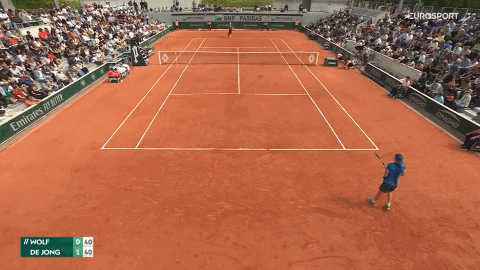
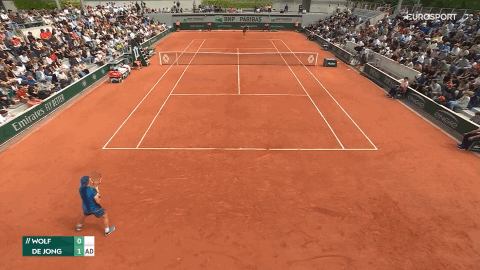

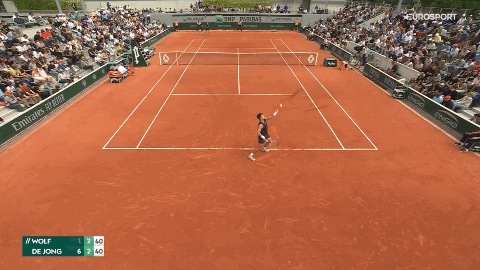
Jesper de Jong's point to 1-0* 40-ad, 1st set (top left), to break 2-0 in the 1st set (top right), to 1-1* 0-15, 2nd set (bottom left), and to *2-2 40-ad, 2nd set (bottom right) (📸 Eurosport GB)
J.J. Wolf might have an unideal start to the season, sustaining an injury in the first round of the Australian Open that resulted in him falling back in the rankings after being unable to defend his fourth-round achievement in 2023, which was followed by a disappointing green-clay campaign as he was defeated by Dmitry Popko and former junior World No. 3 Henry Searle in the first rounds of Sarasota and Tallahassee Challengers, respectively, followed by qualifying for the Turin Challenger main draw only to be defeated by Lorenzo Sonego 3-6, 3-6 in the first round. However, J.J. seemingly picked up where he left off as he battled Ryan Peniston 6-1, 6-7(5), 6-2, and Patrick Kypson 6-3, 6-3 in the first two qualifying rounds of Roland Garros. Almost similarly, despite qualifying for the Australian Open earlier this year, Jesper de Jong also had a similar rollercoaster, as he was unable to defend his Girona Challenger semifinal from last year after being eliminated by Lorenzo Giustino 5-7, 4-6 in the quarterfinals, followed by another quarterfinal achievement in Rome (Italy) Challenger a fortnight later (l. Alejandro Moro Canas). Despite this, he stayed competitive in most of his other runs, proving he was still here to qualify as he defeated another in-form player in Pablo Llamas Ruiz and Dennis Novak to set up this clash. Other than their offensives, this match could test their point construction, and at their best, it all could come down to how they executed their points.
After holding his service game to 1-0 in the first set, J. de Jong started to become more aggressive, forcing the deuce due to J.J.’s forehand error before a drop shot generated his break point, followed by a backhand down-the-line winner to break early (2-0). After a massive hold to 3-0, the Dutch took advantage of J.J.’s erratic service game before doubling the break 4-0, somehow boldening the lead with a service game hold to 5-0. As J. de Jong ended the set by serving a breadstick (6-1), his dominance continued by scoring a forehand pass one point into the third game even if J.J. held his service game to 2-2, which averted the bakery product at some point. However, as hard as J.J. tried to fumble the said break points, J. de Jong increased his offensive ballstriking, coming up with a forehand winner and a drop shot to secure his other 2 break points before it was ultimately converted due to his double fault (3-2). Somehow, increasing his aggression, J. de Jong trusted his forehand well to secure his one-point lead before a failed smash from J.J. secured the former’s 2-point lead, allowing him to double the break before J. de Jong secured another Grand Slam qualification for the year by taking the second set 6-2.
In the first round, J. de Jong will face Jack Draper, with a potential second-round match against Carlos Alcaraz or... a potential rematch of this one. Not an easy one, but considering J. Draper's level on clay, who knows.
Section 1: Filip Misolic def. Quentin Halys 2-6, 6-4, 6-3

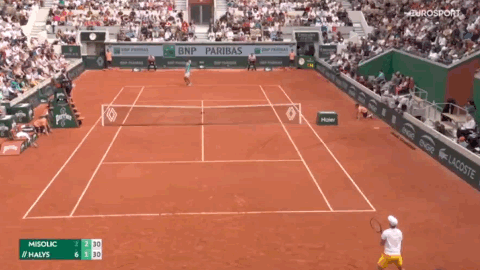
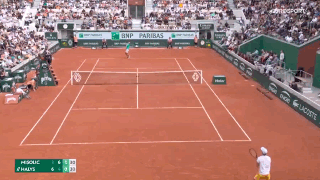
Filip Misolic's points to 2-2* 0-30, 1st set (top left), to 2-1* 30-40, 2nd set (top right), and to 1-0* 30-40, 3rd set (bottom) (📸 Eurosport GB)
Since his Salzburg Challenger first-round meeting against Dominic Thiem despite the loss and reaching the runner-up in Kitzbühel (250) to Roberto Bautista Agut in 2022, F. Misolic's season has been a rollercoaster, including the 6-12 win-lose record before entering the Roland Garros qualifying rounds, with his major result being the quarterfinalist of Split Challenger (l. Zsombor Piros). He somehow found his way to bounce back in the first two qualifying rounds in Roland Garros, as he defeated both Sho Shimabukuro and Ugo Blanchet (who stunned first seed Cristian Garin in the first qualifying round) both in straight sets (6-3, 6-2 and 6-4, 6-2, respectively). Interestingly, outside of his usual hard-court setting, Quentin Halys mostly exited early (despite qualifying for the main draw in the Aix-en-Provence Challenger only to lose 1-6, 2-6 vs. Botic van de Zandschulp) while trying to regain his form, which he might likely rediscover in the Roland Garros qualifying rounds, defeating Alexis Galarneau 7-5, 6-3 and 29th seed Diego Schwartzman 4-6, 6-4, 7-6(7) in a 3-hour-5-minute thriller. This match might also bring the best out of them, with the more offensive player in general taking this match, and it turned out to deliver just that.
F. Misolic might have suffered from a nervy start as he got broken early to 1-0 in the first set, but he steadily tried to trust his forehands, which helped him to generate break points in the fourth game only for Halys to hold to 3-1, where the Frenchman ended up dominating the set by taking it 6-2. However, F. Misolic tried to absorb some pace, where his intuitive volley turned out to create his break point before his forehands once again were trustable enough to secure him the early break to 2-1 to start the second set. Despite being broken back to 4-3, F. Misolic hung in there to hold several games before capitalizing on Halys’ errors to break for the second set (6-4), mostly due to Halys’ forehand errors and a double fault in between. The Austrian carried through the third set, breaking to 2-0 after a lengthy game thanks to his slice pass that created his break point, but Halys’ forehand rushes afterward also did not help. F. Misolic almost broke for the match thanks to his forehand pass to 5-2* 40-ad, but still successfully served for the match to 6-3 as he had to do so.
In the first round, F. Misolic will face Christopher O'Connell. C. O'Connell could be something else on clay, but there is a slight chance that the former will make it as long as he is stable enough with his groundstrokes. Maybe.
Section 5: Roman Andres Burruchaga def. Jozef Kovalik 4-6, 7-6(2), 6-4
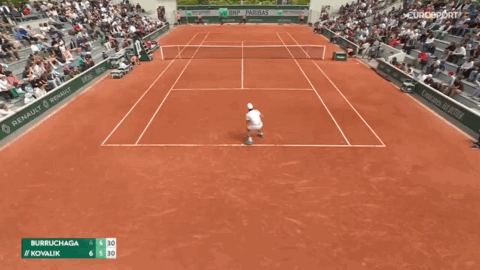
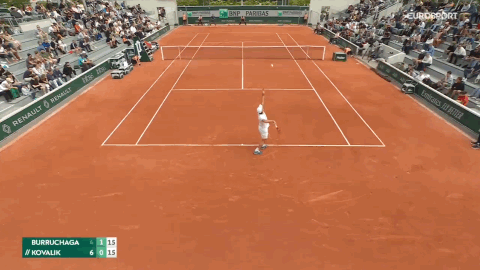

Roman Andres Burruchaga's points to 1-1* 15-30, 2nd set (top left), to *5-4 30-40, 2nd set (top right), and to *3-1 40-15, 3rd set (bottom) (📸 Eurosport GB)
While on paper, some might not expect this section to come down to this encounter, the son of a legendary football player, Jorge Burruchaga, Roman Andres Burruchaga, solidly built his form in his way, most notably defeating Diego Schwartzman 6-1, 4-6, 6-4 in the first round of Cordoba (250), followed by a semifinal showing in Asuncion (l. Joao Fonseca 6-7(5), 6-1, 3-6) and Florianopolis Challengers (l. Enzo Couacaud 2-6, 1-6) before embarking in his European Challengers campaign with a second-round loss to Gerald Melzer, but achieved a semifinal finish in Oeiras 4 Challenger against Jaime Faria 4-6, 7-6(5), 1-6 in another thrilling battle. Not a far stretch, this led him being able to defeat fifth seed Juncheng (Jerry) Shang 6-4, 7-6(5) despite the latter’s likely illness, and Yasutaka Uchiyama 6-2, 6-4 in the first two qualifying rounds. Interestingly, J. Kovalik is also currently in-form, as he was close to winning the Croatian treble since he won the Zadar (d. Adrian Andreev 6-4, 6-2) and Split Challengers (d. Zsombor Piros 6-4, 5-7, 7-5) before becoming the runner-up to a resurgent Lucas Pouille in the Mauthausen Challenger (3-6, 3-6) a fortnight before the Roland Garros qualifying rounds, where he confidently defeated two French veterans in straight sets (Benoit Paire 6-1, 6-4 and Benjamin Bonzi 6-3, 6-2) in the first two qualifying rounds. It could be all to play for in this match, striking the ball as smoothly and accurately as possible to stand out.
This match turned out to be topsy-turvy as their consistency was also tested throughout this match. J. Kovalik initially broke early (1-0 in the 1st set) before consolidating his position, but Roman started to trust his strokes as he scored a backhand pass to hold his serves to 4-1, finally putting his name on the board. Interestingly, a swift return at *5-2 15-30 brought the Argentinean back to the match, breaking to 5-3 even if J. Kovalik took the 1st set 6-4. The Slovak was also up a break in the second set (3-2) due to Roman’s forehand error, but the latter bounced back as he found his groundstrokes, smashing his way to create his break point to *5-4 30-40 before breaking back to 5-5. This then changed the trajectory of the match, as Roman dominated the tie-breaker from the baseline to take the second set 7-6(2) to force the deciding set, where once again, J. Kovalik led by an early break to 3-1 in its beginning thanks to his point construction. It was not over yet for Roman, who fought back thanks to his drop shot to generate his break point before breaking back to 3-2, leveling the play with a service game hold to 3-3. Somehow, Roman did not look back as he still went after J. Kovalik’s forehand errors, which resulted in the former’s break of serve (4-3) and he consolidated it to 5-3. Ultimately, Roman took the third set 6-4, showing his grit to close the match and secure his maiden Grand Slam-level main draw appearance.
In the first round, Roman will face Jan-Lennard Struff, with the winner possibly facing 19th seed Alexander Bublik in the second round. This could be a good test of the former’s depth and aggression, but Struffi is no easy feat when the balance of power is right.
Section 16: Felipe Meligeni R. Alves [23] def. Jaime Faria 6-4, 6-2
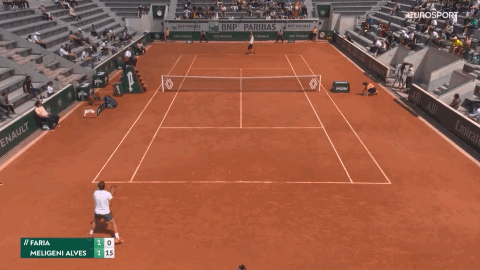
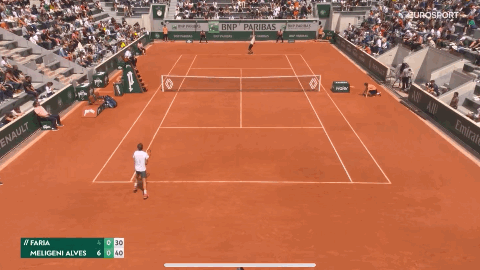

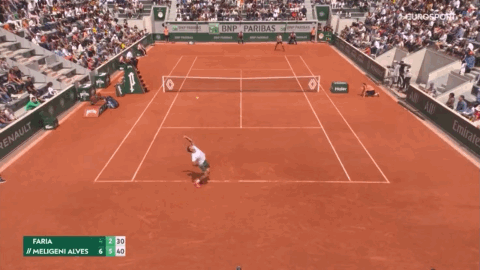
Felipe Meligeni R. Alves' points to *1-1 0-30, 1st set (top left), to *1-1 0-30, 2nd set (top right), to 4-2* 15-15, 2nd set (bottom left), and to take the second set 6-2 (bottom right) (📸 Eurosport GB)
J. Faria had a confident start to the clay season as he qualified for the Estoril (250) as a qualifying wild card by defeating Mate Valkusz and Lukas Klein before bowing out to eventual quarterfinalist David Jorda Sanchis 6-7(4), 1-6 in the first round, followed by a stellar showing in the Oeiras 3 Challenger as a semifinalist despite being comebacked by eventual champion Francisco Comesana 5-7, 7-6(4), 6-0 as he got broken back when he had a one-break advantage in the second set. Despite several earlier exits afterward in the Ostrava Challenger quarterfinals and Prague 2 Challenger second round, J. Faria went on to win his maiden Challenger title in Oeiras 4 (d. Elias Ymer 3-6, 7-6(3), 6-4 to complete his last three-rounds thriller), and continued this form as he defeated Clement Tabur and Zachary Svajda in straight sets, even though he was 1-4 down in the first set for the latter match. Another possibly compelling story came from Felipe, where he reached the semifinals of the Sao Leopoldo Challenger (l. Adolfo Daniel Vallejo) and battled Valentin Vacherot in the second round of the Aix-en-Provence Challenger despite the loss (3-6, 6-3, 6-7(4)), continuing through the quarterfinals of the Turin Challenger where he was defeated by Lorenzo Musetti 1-6, 3-6 after the previous three-set thrillers against Thiago Agustin Tirante and Francesco Maestrelli. Just like J. Faria, Felipe had a strong qualifying campaign here in Roland Garros as he defeated Nerman Fatic and Zdenek Kolar in straight sets, setting up arguably the match of the day (and round) between two in-form players, which, at their best, could be a classic with various twists and turns depending on their balance of power and groundstrokes to stand out in this match.
Initially, J. Faria held his service game to 1-0 to start the first set, but he was unable to capitalize on his 2 break points that were made due to Felipe’s forehand rushes, where the latter turned out to hold his serves to 1-1. It became a crucial hold as Felipe smashed his way to generate his 2-point lead, where he turned out to break to 2-1 as a result of J. Faria’s unforced errors. He then consolidated the lead to 3-1, and despite facing stiff opposition in J. Faria’s aggression, Felipe stood his ground to take the first set 6-4. Somehow, Felipe carried this fine form by breaking early to 1-0 thanks to his forehands, and he had not looked back since. He froze as he fired a successful cross-court forehand lob, where J. Faria asked for a mark-check and it turned out to be in, securing the Brazilian’s equalizer to 4-2* 15-15 before his break doubled due to J. Faria’s double fault. As a result, the 23rd seed earned an opportunity to serve for the match, where his forehand winner perfectly closed it to take the second set 6-2, securing his spot in another Grand Slam-level main draw after last year’s heartbreak of being comebacked.
In the first round, Felipe will face seventh seed Casper Ruud, which turned out to be their first meeting. At their best, this could be a competitive showing boiling down to their shot execution, and while the latter had the slight edge in terms of experience, this clay season could give us anything.
Section 7: Mikhail Kukushkin [25] def. Francesco Maestrelli 6-4, 6-7(4), 6-2

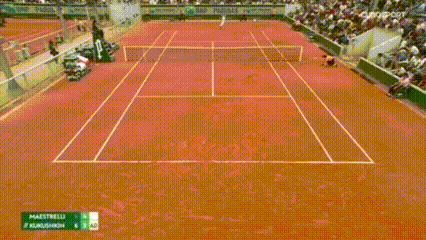

Mikhail Kukushkin's points to *1-1 15-30, 2nd set (top left), to hold 4-4, 2nd set (top right), and to break 5-3, 3rd set (bottom) (📸 Eurosport GB)
While some might not expect this section to come down to this either, both players made their cases en route and during the Roland Garros qualifying rounds. F. Maestrelli built his form starting the semifinal appearance in the Szekesfehervar Challenger (l. Chun-Hsin Tseng), followed by 2 quarterfinal exits in Barletta (l. Damir Dzumhur) and Rome (Italy) (l. Stefano Napolitano) to precede 2 other early exits, followed by another competitive loss against Felipe Meligeni R. Alves 3-6, 6-4, 6-7(4) in the Turin Challenger quarterfinals. In Roland Garros, he battled Marc-Andrea Huesler 6-7(2), 6-2, 6-4 before advancing due to Bernabe Zapata Miralles’ retirement down 1-6 upon the conclusion of the first set in the first two qualifying rounds. On the other hand, 25th seed and former World No. 39 Mikhail Kukushkin resurged back in the hard courts after winning the Manama Challenger title, as well as the Tenerife 3 Challenger title due to Matteo Gigante’s retirement down 2-6, 0-2 in the finals as a qualifier. Despite he often unable to catch a break after some battles, as evident in the Madrid Challenger semifinal when he had to retire down 2-6, 1-4 against eventual champion Stefano Napolitano, he was still able to battle it out when he was ready despite some early exits in Aix-en-Provence Challenger first round (as a qualifier) and the second round of Rome Masters 1000 (l. Diego Schwartzman), both in 3 sets for his most recent records. Interestingly, he won straightforwardly in the Roland Garros qualifying rounds, using his experience to defeat Leandro Riedi 6-4, 6-3 and Li Tu 6-4, 6-2 in the first two rounds. Knowing both players, while this could be both tricky and physical, this match possibly tested their aggression, anticipating the ball as early as possible to stand out in this match.
This match turned out to be a classic that Challenger-level watchers often enjoy. F. Maestrelli had a nervy start as his forehand errors only led to M. Kukushkin breaking early to 1-0, but the Kazakh’s forehand winner generated his break point before he doubled the break (3-0) only to be broken back due to his forehand errors. However, M. Kukushkin still managed to take the first set 6-4, continuing with a drop shot 3 points into the third game (of the second set) before breaking to 2-1. Two games later, F. Maestrelli increased his intensity, breaking back to 3-3 after he got even more aggressive, and M. Kukushkin had a massive hold thanks to winning the 36-shot rally even if he survived a break point to 4-4. He kept passing F. Maestrelli at times, continuing by his masterpieces after masterpieces of point construction in the 12th game to force the tie-breaker, but F. Maestrelli went after his forehands to dominate the tie-break, taking the second set 7-6(4) to force a deciding set. It took several moments before M. Kukushkin once again saved a break point in the sixth game (3-2), and his fight paid off as he secured a break point thanks to his forehand pass to 4-3* 15-40 after a forehand return ace. Afterward, he broke to 5-3 and successfully served for the match (6-3), securing his first Grand Slam appearance since the Wimbledon 2022 and Roland Garros appearance in 3 years (since 2021), the latter where his best result was only the 2nd round in 2011-12, 2014, 2017, and 2020.
In the first round, M. Kukushkin will face Fabian Marozsan. Recognizing the latter’s form and point construction abilities, this match could be tricky, but execution could also play a part. At their best, this could be a thriller, depending on the former’s fitness (hoping he is healthy enough to turn back the clock again).
Section 6: Thiago Monteiro [6] def. Daniel Rincon 6-4, 6-2
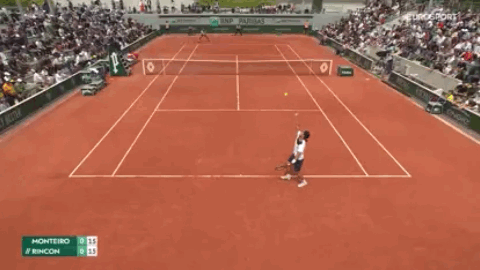
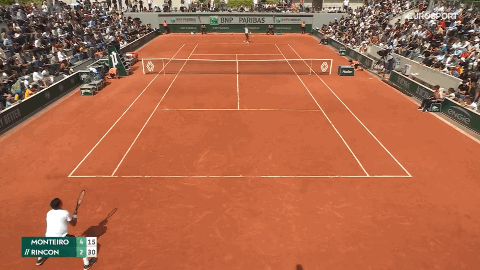

Thiago Monteiro's points to *0-0 15-30, 1st set (top left), to 4-2* 30-30, 1st set (top right), and to 2-2* 0-15, 2nd set (bottom) (📸 Eurosport GB)
T. Monteiro might have had a disastrous end-of-season by having to retire down 4-6, 3-4 against Facundo Diaz Acosta back in Montevideo Challenger last year due to a wrist injury to add salt to the wound, taking into account his topsy-turvy second-half of last season, where he officially started his season in Punta del Este Challenger instead with a quarterfinal loss to Roman Andres Burruchaga. He began to rebuild steadily by reaching the semifinals of the Santa Cruz Challenger without dropping a set, except when he lost to Camilo Ugo Carabelli 4-6, 5-7 in the mentioned round. While it looked like the end of the tunnel back in the Oeiras 3 Challenger as he lost to Jaime Faria 2-6, 6-3, 6-7(2), he resurged in his subsequent tournaments as a qualifier by reaching the third round of the Madrid Masters 1000 after stunning former World No. 3 Stefanos Tsitsipas 6-4, 6-4 despite the loss to Jiri Lehecka 4-6, 6-7(7) afterward, and reaching the fourth round of the Rome Masters 1000 before bowing out to Zhizhen Zhang 6-7(4), 3-6, continuing this trail as he defeated Murkel Dellien 6-4, 6-1 and Valentin Royer 3-6, 6-3, 6-4 in the first two qualifying rounds of Roland Garros. On the other hand, D. Rincon also balanced his Challenger and ITF appearances to secure his spot in the Roland Garros qualifying rounds as he tried to regain his form, as he notably eliminated in the second round of the Ostrava Challenger (l. Timofey Skatov) and became a semifinalist in ITF M25 Sabadell (Apr 29) as he was defeated by Nikolas Sanchez Izquierdo 4-6, 0-6. Starting his Roland Garros qualifying campaigns, he turned out to emerge victorious after two 3-set matches in his first two qualifying round matches against 24th seed Jurij Rodionov 2-6, 7-5, 6-2 and Aziz Dougaz 6-7(6), 6-2, 6-2, setting up this intriguing clash for the third qualifying round. This encounter could also be saved for the last, testing their aggression and their pressure points handling at their best since the margin could have looked thin within both players, which made this match exciting to watch.
In contrast, this match went straightforward instead as soon as T. Monteiro clicked his forehand, found his aggression, and maintained his range well. Just in the first game, T. Monteiro scored a fourth-shot forehand winner before generating his break point similarly, outhitting D. Rincon’s forehand side to break early (1-0). D. Rincon had his fair chances midway as the second game turned out to be an out-passing contest, but T. Monteiro managed to consolidate his lead to 2-0, and he almost doubled the break thanks to his forehand before the Spaniard held to 4-3. The Brazilian sixth seed then took the first set 6-4, and he dominated the flow since, disguising his drop shot as if he was about to hit a volley at the first point of the fifth game (in the second set) before he broke to 3-2, holding his service game right after (4-2). Subsequently, through a forehand pass to D. Rincon’s volley error, T. Monteiro doubled the break to 5-2, serving it out (6-2) to complete the assignment and advance to the main draw.
In the first round, T. Monteiro will face Miomir Kecmanovic. It will be their third Tour-level meeting (fourth overall) as both players shared a meeting apiece on the main Tour. Somehow, this will be a rematch of their Rome Masters 1000 third-round encounter, where T. Monteiro won 6-2, 4-6, 7-6(6). Another potential tight contest underway, but M. Kecmanovic might need to step up his aggression a little under pressure to get out of more trouble.
Section 9: Henri Squire def. Andrea Vavassori 6-3, 3-6, 6-4
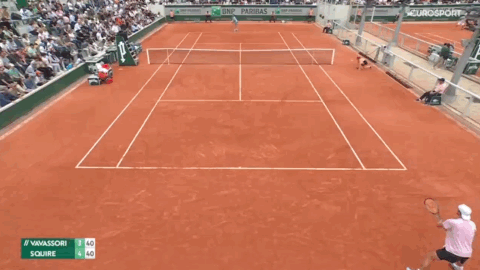
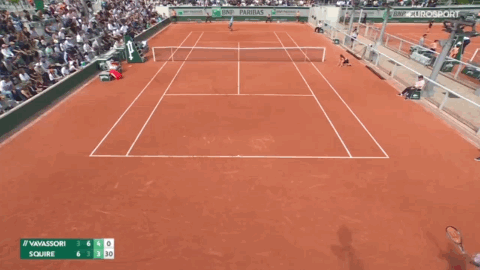


Henri Squire's point to 3-3* 40-ad (earlier break point, 1st set, top left), to 1-1* 0-30, 3rd set (top right), to 4-3* ad-40 (latest game point, 3rd set, bottom left), and to 5-4* 40-ad (latest match point, 3rd set, bottom right) (📸 Eurosport GB)
While he has a stellar doubles career with a runner-up in the Australian Open and has 3 Masters 1000 semifinals to his name (Indian Wells, Madrid, and Rome), A. Vavassori still tried to make it out in singles, beginning his clay season in the Buenos Aires (250) as he qualified for the main draw despite the loss against Carlos Alcaraz 6-7(1), 1-6 in the second round. Despite his rollercoaster singles showing on clay, his best result turned out to be the Barcelona (500) second round against Roberto Bautista Agut, where he lost 6-4, 3-6, 1-6. Through his patience, he battled it out in the first two qualifying rounds of Roland Garros by defeating fourth seed Albert Ramos Vinolas 6-3, 4-6, 6-3, and Benjamin Hassan 6-7(5), 7-6(2), 6-0 to advance to the third qualifying round. Here, he set up a clash with Henri Squire, who started his clay season by reaching the quarterfinal of the Split Challenger (l. Benjamin Bonzi) and notably became a runner-up to Damir Dzumhur in the Ostrava Challenger after being unable to serve it out from 5-1 in the third set that Dzumhur made a comeback win to 6-2, 4-6, 7-5 for the title. Continuing his clay season with some early exits in Prague 2 (l. Leandro Riedi) and Bordeaux Challengers (l. Matteo Martineau), H. Squire turned out to assert his revenge on Dzumhur in his first qualifying round win in Roland Garros 2-6, 6-3, 6-4 before confidently defeating Hugo Grenier 6-2, 6-4 in the subsequent round. Realizing both players’ point construction prowess, this match, at its best, could turn out to depend on their execution of these points, which determined the rest of the flow as well.
It took six consecutive holds for H. Squire to finally come up with something, this time with a working volley for his one-point lead before holding his serves to 4-3 in the first set. Suddenly, taking advantage of A. Vavassori’s preceding errors, the German had several break points, one of which was created thanks to a drop shot (and another one with his preceding backhand, followed by his drop shot) before breaking to 5-3, where he went on to take the first set 6-3. Even if H. Squire was up a break to 2-1 as a result of A. Vavassori’s unforced errors, the Italian went back into the match thanks to his backhand pass before he held to 4-3, somehow breaking for the match due to H. Squire’s forehand errors, topped by a double fault before returning the favor and took the second set 6-3. As a result, they went to the deciding set, where it looked like A. Vavassori was about to complete his comeback by breaking to 2-1, but H. Squire capitalized on the former’s error spree to break back 4-4, bravely saving his break points until hitting the drop shot and lob combination for his latest game point before a crucial hold to 5-4. Since then, the German tried to utilize his point construction in his favor while bringing A. Vavassori off-balance, generating his latest match point through a double drop shot that ended with a forehand pass before breaking for the match (6-4) to secure his first-ever Grand Slam main draw showing.
In the first round, H. Squire will face Max Purcell. The Australian had a rough patch lately in singles, with some notable early exits even in the Asian hard-court Challengers as he tried to maintain his Top 100 ranking. There might be a slight chance for the former on condition that he keeps his point construction stable enough to overwhelm the latter.
Section 8: Zizou Bergs def. Mathias Bourgue 6-2, 7-6(4)

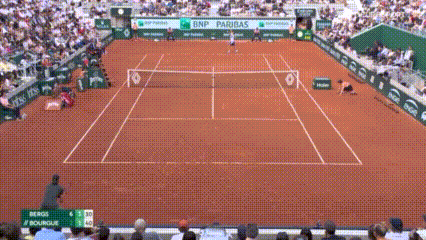
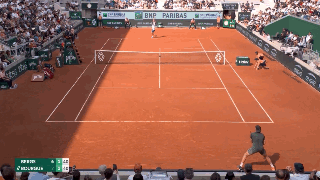
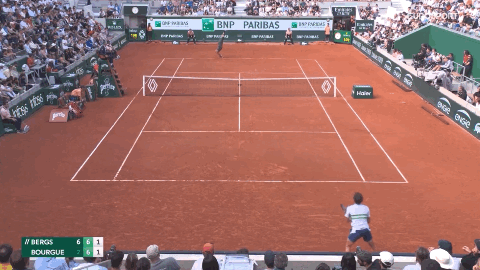
Zizou Bergs' points to 5-1* 40-40, 1st set (top left), to 1-1* 40-40, 2nd set (top right) and to 1-1* 40-ad, 2nd set (bottom left), and to 6-6(2-1, 2nd set tie-break) (bottom right) (📸 Eurosport GB)
Z. Bergs came into the Roland Garros qualifying rounds on fire, as he confidently started the green clay season with a runner-up finish in the Sarasota Challenger (l. Thanasi Kokkinakis) and successfully defended his title in the Tallahassee Challenger (d. Mitchell Krueger) before being rewarded with the Madrid Masters 1000 wild card, where he was defeated by Luca van Assche 6-4, 6-7(0), 6-1. He then confirmed his Top 100 ascension by qualifying for the Rome Masters 1000, defeating both Patrick Kypson (4-6, 6-3, 6-4) and Juncheng (Jerry) Shang (6-4, 7-6(5)) before facing former World No. 1 Rafael Nadal in the first round, which he took a set from in the first set before the 6-4, 3-6, 4-6 loss. Right afterward, he went straight to the Roland Garros qualifying rounds as he defeated wild card Clement Chidekh 6-1, 6-1 and Joris de Loore 6-4, 2-6, 6-4, the latter in an all-Belgian classic clash. Z. Bergs then faced a resurging wild card in former World No. 140 Mathias Bourgue, where he juggled between the Challengers and ITFs to stay on track, to no avail, with most ending in early exits, with his significant result being a second-round loss to Radu Albot 6-7(5), 6-2, 4-6 in the Murcia Challenger, and notably defeated Duje Ajdukovic 6-3, 6-4 in the first qualifying round of the Bordeaux Challenger before being defeated by Quentin Halys 4-6, 4-6 then. The Frenchman then suddenly rediscovered his form in 3-set victories against wild card (even 10 years younger and currently emerging) Mae Malige 4-6, 6-2, 6-2 before stunning 26th seed Radu Albot 1-6, 6-4, 6-4 in the second qualifying round. Knowing Z. Bergs’ form, this match-up could probably be tough for M. Bourgue to match in terms of pace (and power) on paper, but anything could still be possible if the latter dug deeper than his first two matches in this tournament.
Z. Bergs had a dominant start to the match as he broke early to 1-0 in the first set, where he consolidated his lead to 2-0 and even doubled the break thanks to his drop volley to M. Bourgue’s forehand error (4-1). He almost baked the first-set breadstick after forcing the deuce thanks to his functional lob, but he settled by taking the set 6-2 as M. Bourgue held the previous game. The Belgian’s point construction suddenly peaked thanks to his intuitive forehand pass to force a deuce in the third game of the second set before he created his break point through his drop shot, ultimately breaking to 2-1 only to be broken back to 2-2. Somehow, the eighth seed broke back again thanks to his forehand down-the-line winner (3-2) and had not looked back since, but he had to overcome tightness as M. Bourgue increased his level with an insane crowd backing, where he was unable to serve for the match twice (at *5-4 and *6-5) as he tried to regain his range every time. The second tie-breaker then happened, where Z. Bergs’ pass secured his lead to 2-1 before M. Bourgue’s double-fault confirmed the former’s mini-break (3-1), and even if he had a match point saved due to his +1 forehand rush (6-4), an unreturned serve cleaned up his act to take the second set 7-6(4), as well as sealing the last qualifier spot of the tournament to conclude the opening week.
In the first round, Z. Bergs will face 24th seed Alejandro Tabilo, who reached a new height of his career after winning the Aix-en-Provence Challenger and becoming a semifinalist of the Rome Masters 1000. This could be a 5-set tussle at their best, emphasizing the execution of their shots along the way. Perhaps a highlight-reel-inducing match as well!
The lucky losers will be featured in the subsequent article.
#atp world tour#atp tour#grand slam#french open#roland garros#roland garros 2024#tennis updates#hot shots#break point#match point#jesper de jong#j.j. wolf#filip misolic#quentin halys#roman andres burruchaga#jozef kovalik#felipe meligeni alves#jaime faria#mikhail kukushkin#francesco maestrelli#thiago monteiro#daniel rincon#henri squire#andrea vavassori#zizou bergs#mathias bourgue#know your qualifiers
0 notes
Text
0 notes
Text
Week 7: Body Modification
The pornification of, well, everything is something that has been bothering me recently. Let's speak about it. The primary source of this is social media, but it can be found everywhere: in obscenely provocative advertisements and influencer photos in skimpy attire. It seems strange when everything starts to resemble a softcore music video, don't get me wrong, I'm all for body positivity and confidence. Consider this: how often have you felt that your Instagram feed is merely a series of thirst-quenchers when you browse through it? It wears me out! Furthermore, it might be quite disorienting for younger kids to be inundated with these pictures all the time. It doesn't precisely provide positive standards for partnerships and dating.

The term "pornification" describes how advances in technology have affected the production, accessibility, and use of pornographic material. Pornification can also refer to broad opening up and deregulation processes in the domain of pornography, in addition to technical advances in the media (Paasonen 2016). Pornification is the portrayal of straight people in a way that is 'porn chic' with the intention of appealing to men (Drenten, Gurrieri, & Tyler 2019). Particularly in the present day, a growing number of social media platforms permit pornographic content. Instagram, one of the largest social media platforms worldwide, has experienced issues with pornography. Despite the implementation of material control and community guidelines, sexually explicit or suggestive information can still be found on Instagram.

It's time to press the reset button. Although social media may be a fantastic medium for expressing oneself, the main goal shouldn't be to appear as though you belong on a magazine cover. Let's honor uniqueness, originality, and authenticity! More exists in life and in each of us than counting the number of likes we can get on a skimpy selfie. To be more specific, Instagram users who want to participate in controlled sexualized shoutouts can take a screenshot of a female user's uploaded image, submit it to the page, and tag the original user in the image or description. As a result, sexualized shoutout pages serve as a methodical starting point for our search for specific female Instagram users who have garnered a lot of attention (Drenten, Gurrieri & Tyler 2019). They also reflect attention currency on the network. Taking everything into consideration, the utilization of microcelebrities underscores the significance of producing and consuming content responsibly, given the social ramifications of pornography. By acknowledging the ways in which production, distribution, and consumption influence societal perspectives on health and body image, we can create a more encouraging and welcoming atmosphere for everybody. Laws that prioritize mental health and well-being must be changed, as well as increased awareness and education, in order to address negative body image and body dysmorphic disorder.
Reference list
Drenten, J, Gurrieri, L & Tyler, M 2019, ‘Sexualized labour in digital culture: Instagram influencers, porn chic and the monetization of attention’, Gender, Work & Organization, vol. 27, no. 1.
Paasonen, S, Kaarina Nikunen & Saarenmaa, L 2007, Pornification : sex and sexuality in media culture, Berg, Oxford ; New York, N.Y.
0 notes
Text
Exploring the Marvels of Biological Macromolecules: The Molecular Machinery of Life (Part 3)
Proteins and Enzymes: Catalysts of Molecular Reactions
Proteins are the central players in macromolecular interactions. Enzymes, a specialized class of proteins, catalyze biochemical reactions with remarkable specificity. They bind to substrates, facilitate reactions, and release products, ensuring that cellular processes occur with precision.
Protein-Protein Interactions: Orchestrating Cellular Functions
Proteins often interact with other proteins to form dynamic complexes. These interactions are pivotal in processes such as signal transduction, where cascades of protein-protein interactions transmit signals within cells, regulating diverse functions such as growth, metabolism, and immune responses.
Protein-Ligand Interactions: Molecular Recognition
Proteins can also interact with small molecules called ligands. Receptor proteins, for instance, bind to ligands such as hormones, neurotransmitters, or drugs, initiating cellular responses. These interactions rely on specific binding sites and molecular recognition.
Protein-DNA Interactions: Controlling Genetic Information
Transcription factors, a class of proteins, interact with DNA to regulate gene expression. They bind to specific DNA sequences, promoting or inhibiting transcription, thereby controlling RNA and protein synthesis.
Membrane Proteins: Regulating Cellular Transport
Integral membrane proteins participate in macromolecular interactions by regulating the transport of ions and molecules across cell membranes. Transport proteins, ion channels, and pumps interact precisely to maintain cellular homeostasis.
Cooperativity and Allosteric Regulation: Fine-Tuning Cellular Processes
Cooperativity and allosteric regulation are mechanisms that modulate protein function. In cooperativity, binding one ligand to a protein influences the binding of subsequent ligands, often amplifying the response. Allosteric regulation occurs when a molecule binds to a site other than the active site, altering the protein's conformation and activity.
Interactions in Signaling Pathways: Cellular Communication
Signal transduction pathways rely on cascades of macromolecular interactions to transmit extracellular signals into cellular responses. Kinases and phosphatases, enzymes that add or remove phosphate groups, play pivotal roles in these pathways.
Protein Folding and Misfolding: Disease Implications
Proteins must fold into specific three-dimensional shapes to function correctly. Misfolded proteins can lead to Alzheimer's, Parkinson's, and prion diseases. Chaperone proteins assist in proper protein folding and prevent aggregation.
References
Voet, D., Voet, J. G., & Pratt, C. W. (2016). Fundamentals of Biochemistry: Life at the Molecular Level. Wiley.
Lehninger, A. L., Nelson, D. L., & Cox, M. M. (2017). Lehninger Principles of Biochemistry. W. H. Freeman.
Berg, J. M., Tymoczko, J. L., & Stryer, L. (2002). Biochemistry. W. H. Freeman
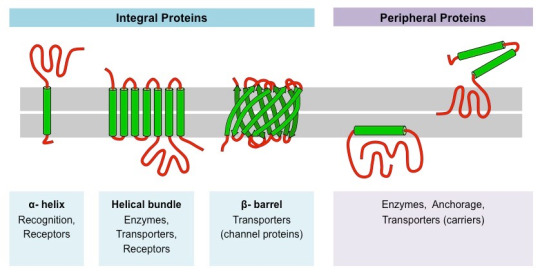
#science#college#biology#education#school#medicine#student#doctors#health#healthcare#proteins#molecular biology#molecular structure#chemestry#chemistry
97 notes
·
View notes
Text
Blog 08: Sense-Making of Nature Interpretation
Hey everyone, and welcome back for another blog post. In today’s prompt we are discussing the most amazing things we know about nature. For me, what comes to mind first would be the magnificent northern lights. Though I have never had the chance to see them in person, I can tell how breathtaking they would be just from pictures, videos, and descriptions.

The northern lights are scientifically known as aurora borealis, meaning the light of dawn. They can be seen from the northern hemisphere in regions such as Canada, Alaska, Russia, Norway, and Sweden since these places cover the auroral oval (Waldek & Dobrijevic, 2022). However, since auroral activity is not always consistent, the oval can shift. An aurora refers to a natural light display projected in the sky (National Geographic, 2023). They can appear when charged solar wind particles from the sun approach the Earth as solar wind. These particles are able to interact with the Earth’s magnetic field (National Geographic, 2023). Most of this solar wind gets blocked by the magnetosphere, but some ions do get trapped. The area where ions are trapped in the atmosphere is called the ionosphere. Within the ionosphere, nitrogen and oxygen atoms from the Earth’s atmosphere collide (National Geographic, 2023). The energy from this collision creates the fascinating glowing lights we see as the northern lights. The colours of an aurora are influenced by altitude, as well as the atoms that are involved (National Geographic, 2023). oxygen atoms tend to produce a red colour, however this is rare as it happens only when the ions are striked high in the atmosphere. Commonly, oxygen produces green/yellow auroras. When hydrogen and helium atoms are striked, blue and purple hues can be seen (National Geographic, 2023).
Auroras have a deep meaning in several cultures as well. In Iceland, it is thought that looking at the northern lights directly would cause your child to become cross-eyed (Berg, 2023). In Finland, the Sami Indigenous people believe that the lights must be respected (Berg, 2023). In their culture, the auroras are considered to be living beings, and that misfortune would come upon you if you were to disrespect them (Berg, 2023). As I have mentioned before in Blog 7, music is also an important part of the Sami Indigenous culture as they communicate through song, by singing yoiks (Gray et al., 2001).
The northern lights are just one of nature’s several wonders. As interpreters, it is necessary for us to appreciate and understand the elements of nature in order to share our findings with our audiences (Beck et al., 2018). By surrounding ourselves in nature’s beauty, we can build a profound connection to it. As I continue to grow as an interpreter, I hope to both inspire and inform others about culture & nature (Beck et al., 2018).
References
Aurora - National Geographic. Retrieved 18 March 2024, from https://education.nationalgeographic.org/resource/aurora
Beck, L., Cable, T. T., & Knudson, D. M. (2018). Interpreting Cultural and Natural Heritage: For A Better World. Sagamore Publishing.
Berg, B. (2023, March 28). What the Northern Lights Mean to Different Cultures - AFAR. AFAR Media. https://www.afar.com/magazine/what-the-northern-lights-mean-to-different-cultures
Gray, P. M., Krause, B., Atema, J., Payne, R., Krumhansl, C., & Baptista, L. (2001). The Music of Nature and the Nature of Music. Science, 291(5501), 52–52. https://go.gale.com/ps/i.do?p=AONE&sw=w&issn=00368075&v=2.1&it=r&id=GALE%7CA69270354&sid=googleScholar&linkaccess=abs
Waldek, S., & Dobrijevic, D. (2022, March 13). Aurora Borealis: What Causes The Northern Lights & Where to See Them. Space.Com. https://www.space.com/15139-northern-lights-auroras-earth-facts-sdcmp.html
0 notes
Text
🧐 This Week’s Spotlight Reads & Book Recommendations
➱ DIRTY SAINT (Sons of Sinister) by Tabatha Vargo Son of Sinister. Drug dealer. The number one stunner on The Strip and a BIG FAT LIAR.
➱ The Secrets We Keep: A Small Town Fake Dating Romance by J.L. Berg Passions ignite when a small-town cop falls for the one woman he shouldn’t in this fake dating romance.
➱ Peacemaker a Steampunk MM Romance by Morgan Brice
Secret agents, forbidden love, danger, and magic!
#JLBerg#TabathaVargo#MorganBrice#BookRecommendations#NewRelease#wahttoread#SmallTownRomance#NewAdult#MCRomance#steampunk#lgbt#Mystery#Audiobook
0 notes
Text
Interesting Papers for Week 14, 2023
Adaptation-induced plasticity in the sensory cortex. Bharmauria, V., Ouelhazi, A., Lussiez, R., & Molotchnikoff, S. (2022). Journal of Neurophysiology, 128(4), 946–962.
NMDAR-dependent presynaptic homeostasis in adult hippocampus: Synapse growth and cross-modal inhibitory plasticity. Chipman, P. H., Fetter, R. D., Panzera, L. C., Bergerson, S. J., Karmelic, D., Yokoyama, S., … Davis, G. W. (2022). Neuron, 110(20), 3302-3317.e7.
A locus coeruleus-dorsal CA1 dopaminergic circuit modulates memory linking. Chowdhury, A., Luchetti, A., Fernandes, G., Filho, D. A., Kastellakis, G., Tzilivaki, A., … Silva, A. J. (2022). Neuron, 110(20), 3374-3388.e8.
Neural interactions in working memory explain decreased recall precision and similarity-based feature repulsion. Johnson, J. S., van Lamsweerde, A. E., Dineva, E., & Spencer, J. P. (2022). Scientific Reports, 12, 17756.
Foveal vision anticipates defining features of eye movement targets. Kroell, L. M., & Rolfs, M. (2022). eLife, 11, e78106. https://doi.org/10.7554/eLife.78106
Neuromodulator-dependent synaptic tagging and capture retroactively controls neural coding in spiking neural networks. Lehr, A. B., Luboeinski, J., & Tetzlaff, C. (2022). Scientific Reports, 12, 17772.
Cone opponent functional domains in primary visual cortex combine signals for color appearance mechanisms. Li, P., Garg, A. K., Zhang, L. A., Rashid, M. S., & Callaway, E. M. (2022). Nature Communications, 13, 6344.
U(1) dynamics in neuronal activities. Lin, C.-Y., Chen, P.-H., Lin, H.-H., & Huang, W.-M. (2022). Scientific Reports, 12, 17629.
Movement is governed by rotational neural dynamics in spinal motor networks. Lindén, H., Petersen, P. C., Vestergaard, M., & Berg, R. W. (2022). Nature, 610(7932), 526–531.
A visual sense of number emerges from divisive normalization in a simple center-surround convolutional network. Park, J., & Huber, D. E. (2022). eLife, 11, e80990.
Multiple forms of working memory emerge from synapse–astrocyte interactions in a neuron–glia network model. Pittà, M. De, & Brunel, N. (2022). Proceedings of the National Academy of Sciences, 119(43), e2207912119.
Tonic activity in lateral habenula neurons acts as a neutral valence brake on reward-seeking behavior. Post, R. J., Bulkin, D. A., Ebitz, R. B., Lee, V., Han, K., & Warden, M. R. (2022). Current Biology, 32(20), 4325-4336.e5.
The globalizability of temporal discounting. Ruggeri, K., Panin, A., Vdovic, M., Većkalov, B., Abdul-Salaam, N., Achterberg, J., … García-Garzon, E. (2022). Nature Human Behaviour, 6(10), 1386–1397.
Neural representational geometry underlies few-shot concept learning. Sorscher, B., Ganguli, S., & Sompolinsky, H. (2022). Proceedings of the National Academy of Sciences, 119(43), e2200800119.
Spatial representation by ramping activity of neurons in the retrohippocampal cortex. Tennant, S. A., Clark, H., Hawes, I., Tam, W. K., Hua, J., Yang, W., … Nolan, M. F. (2022). Current Biology, 32(20), 4451-4464.e7.
Persistent activity in human parietal cortex mediates perceptual choice repetition bias. Urai, A. E., & Donner, T. H. (2022). Nature Communications, 13, 6015.
Balance between breadth and depth in human many-alternative decisions. Vidal, A., Soto-Faraco, S., & Moreno-Bote, R. (2022). eLife, 11, e76985.
Attentional priority is determined by predicted feature distributions. Witkowski, P. P., & Geng, J. J. (2022). Journal of Experimental Psychology: Human Perception and Performance, 48(11), 1201–1212.
Spontaneous perspective taking of an invisible person. Zhou, J., Peng, Y., Li, Y., Deng, X., & Chen, H. (2022). Journal of Experimental Psychology: Human Perception and Performance, 48(11), 1186–1200.
Reward and aversion processing by input-defined parallel nucleus accumbens circuits in mice. Zhou, K., Xu, H., Lu, S., Jiang, S., Hou, G., Deng, X., … Zhu, Y. (2022). Nature Communications, 13, 6244.
#science#Neuroscience#computational neuroscience#Brain science#research#cognition#cognitive science#neurons#neural networks#neural computation#neurobiology#psychophysics#scientific publications
12 notes
·
View notes
Text
Democratic Party
** Formed in 1848, the Democratic National Committee has been the home base for the Democratic Party, one of the oldest political parties in the United States
The Democratic Party is focused on advancing their Democratic Platform and looking for positive solutions that include everyone.
Their stance on, what would be considered, issues for major political debate would be:
Every person in this nation should be treated with dignity and respect
Health care is a right for all
Hard work of middle class families should be rewarded
Schools and streets should be free from gun violence
Women should be able to make decisions about her own body
Candidates
Aaron M. He (A: 4/26/23; Insufficient Funds)
Adam Ouariti (A: 3/31/21; Insufficient Funds)
Adrian Maurice Hall (A: 6/29/23; Insufficient Funds)
Ajay Thaliath (A: 1/27/29; Insufficient Funds)
Alida Felton (A: 4/6/23; Insufficient Funds)
Alan Huddleston (A: 1/5/23; Insufficient Funds)
Allan Channey Summers (A: 6/14/23; Insufficient Funds)
Amanda Catherine Eskelson (A: 8/22/23; Insufficient Funds)
Angad Singh Chera (A: 10/16/23; Insufficient Funds)
Ann Parkinson (A: 6/28/23; Insufficient Funds)
Anthony Manalakos (A: 6/8/23; Insufficient Funds)
Antonio Marco Pantalo (A: 11/17/22; Insufficient Funds)
Armando Pereze-Serrato (A: 1/19/23; Insufficient Funds)
Arse Vincent Cysewski (A: 1/23/22; Insufficient Funds)
Ashley Powell (A: 2/9/18; Insufficient Funds)
Azeem Hussein (A: 5/2/23; Insufficient Funds)
Beatrice Ramos (A: 1/3/24; Insufficient Funds)
Bella Berg Fonvergne (A: 12/15/23; Insufficient Funds)
Benjamin Garcia (A: 7/27/20; Insufficient Funds)
Bill Thomas Compton (A: 3/24/21; Insufficient Funds)
Brian Matthew Owen (A: 5/20/23; Insufficient Funds)
Brittany A. Mckown (A: 1/5/22; Insufficient Funds)
Bryan James (A: 4/5/23; Insufficient Funds)
Carson Loveless (A: 5/2/23; Insufficient Funds)
Cenk Uygur (A: 10/11/23; Insufficient Funds)
Charles Camilleri (A: 4/20/23; Insufficient Funds)
Christin Noel Powers (A: 7/15/22; Insufficient Funds)
Christopher Campbell (A: 2/9/21; Insufficient Funds)
Christopher David Portlock (A: 7/21/23; Insufficient Funds)
Chris Weiler (A: 7/18/23; Insufficient Funds)
Constance L. Johnson (A: 10/24/23; Insufficient Funds)
Coran De-Andre Smith (A: 10/9/23; Insufficient Funds)
Dantwan Samuel Watkins (A: 1/26/23; Insufficient Funds)
David Barnard (A: 6/4/23; Insufficient Funds)
David Cash (A: 5/3/21; Insufficient Funds)
David Curtis Jefferson (12/7/22; Insufficient Funds)
Dean Phillips (A: 10/26/23; Insufficient Funds)
Deborah Sharpe (A: 6/15/23; Insufficient Funds)
Donald Picard (A: 10/6/23; Insufficient Funds)
Doris Brown (A: 10/2/23; Insufficient Funds)
Dorsey Porter (A: 11/16/22; Insufficient Funds)
Dustin Rorex (A: 4/26/23; Insufficient Funds)
Dykeba Lecole Rogers (A: 8/22/22; Insufficient Funds)
Earl Davis (A: 1/19/23; Insufficient Funds)
Eban Cambridge (A: 10/17/23; Insufficient Funds)
Edward Nathaniel Grimes (A: 8/30/23; Insufficient Funds)
Erik Leckner (A: 4/28/22; Insufficient Funds)
Ethan Witzling Hamby (A: 6/30/22; Insufficient Funds)
Evette Rechelle Tippett (A: 6/5/22; Insufficient Funds)
Frank J. Lozada (A: 11/9/23; Insufficient Funds)
Gabriel Cornejo (A: 10/26/23; Insufficient Funds)
Gary Davis (A: 3/16/23; Insufficient Funds)
Gary J. Brown (A: 8/18/23; Insufficient Funds)
George Brucato (A: 4/16/22; Insufficient Funds)
Gerry Coleman (A: 4/21/23; Insufficient Funds)
Gibran Nicholas (A: 3/19/23; Insufficient Funds)
Golda D. Harris (A: 11/1/23; Insufficient Funds)
Gregory Marquis Thomas (A: 11/19/22; Insufficient Funds)
Harvey Wizard (A: 11/15/23; Insufficient Funds)
Heather Munoz (A: 11/7/20; Insufficient Funds)
Herbert Ezekiel Zeke Smyth (A: 4/3/22; Insufficient Funds)
Howard Dotson (A: 2/28/23; Insufficient Funds)
Hudson Theodore Zoller (A: 11/22/22; Insufficient Funds)
Hung Huynh Chan (A: 6/21/22; Insufficient Funds)
Isaiah Reid (A: 11/22/20; Insufficient Funds)
Jamarion Walker (A: 11/4/23; Insufficient Funds)
James Nixon (A: 7/26/20; Insufficient Funds)
James Orlando Ogle III (A: 3/7/22; Insufficient Funds)
Jason Palmer (A: 10/22/23)
Jeff Miles (A: 8/16/23; Insufficient Funds)
Jennifer Astello (A: 12/28/22; Insufficient Funds)
Jennifer Lee Ann Ney (A: 2/10/22; Insufficient Funds)
Jennifer McMurray (A: 10/31/22; Insufficient Funds)
Jodie Smithson (A: 11/7/22; Insufficient Funds)
Joe Exotic (Joseph Allen Maldonado) (A: 4/18/23; Insufficient Funds)
John Coyne (A: 8/19/23; Insufficient Funds)
John Gagliardi (A: 1/13/22; Insufficient Funds)
John Washington III (A: 3/26/23; Insufficient Funds)
Jonathan Tuan Tran (A: 11/15/22; Insufficient Funds)
Jose Font (A: 10/5/23; Insufficient Funds)
Joseph Firmage (A: 10/11/23; Insufficient Funds)
Joseph Jay Manger (A: 11/30/22; Insufficient Funds)
Joseph R Biden Jr (A: 9/5/23)
Joshua David Horwitz (A: 10/4/23; Insufficient Funds)
Julie Jones (A: 4/21/23; Insufficient Funds)
Kacey Nicole Samples (A: 4/24/23; Insufficient Funds)
Keira Anne Walker (A: 4/7/23; Insufficient Funds)
Keith Smith (A: 5/18/23; Insufficient Funds)
Kelan Farrell-Smith (A: 10/30/21; Insufficient Funds)
Kenny Taylor (A: 9/8/23; Insufficient Funds)
Kevin Gilroy (A: 6/3/22; Insufficient Funds)
Kevin John Carney (A: 10/14/23; Insufficient Funds)
Kina Shamier Kerry (A: 9/29/23; Insufficient Funds)
Kristopher Lee Davis (A: 11/19/22; Insufficient Funds)
Larry D. Azevedo (A: 2/8/23; Insufficient Funds)
Lee Mercer Jr. (A: 7/26/22; Insufficient Funds)
Lee Rhodes (A: 3/12/21; Insufficient Funds)
Lindsay Kelch (A: 11/16/22; Insufficient Funds)
Lord A.C. Toulme Jr. (A: 10/20/21; Insufficient Funds)
Lori Ann Henriques (A: 3/5/23; Insufficient Funds)
Marcus Alexander Branch (A: 11/28/22; Insufficient Funds)
Marianne Williamson (A: 2/23/23)
Mark Richard Prascak (A: 9/8/23; Insufficient Funds)
Mark Stewart Greenstein (A: 6/1/23; Insufficient Funds)
Martin Foster Robbins (A: 8/12/23; Insufficient Funds)
Mary Clement (A: 6/8/23; Insufficient Funds)
Mattie Preston (A: 1/6/23; Insufficient Funds)
Michael Chad Lemere (A: 8/6/23; Insufficient Funds)
Michael D'Ottavio (A: 11/9/20; Insufficient Funds)
Michael D. Swing (A: 1/14/22; Insufficient Funds)
Michael Landingham (A: 11/21/22; Insufficient Funds)
Michael Noonan (A: 6/21/23; Insufficient Funds)
Michael Soetaert (A: 12/23/23; Insufficient Funds)
Michael Steinberg (A: 7/2/23; Insufficient Funds)
Michael Tillinghast (A: 5/25/23; Insufficient Funds)
Mikey Lane (A: 11/26/21; Insufficient Funds)
Nancy Elizabeth Rodriguez (A: 5/3/22; Insufficient Funds)
Nicolae Bunea (A: 7/8/22; Insufficient Funds)
Nita Mildred Rice (A: 3/7/23; Insufficient Funds)
Pedro J. Velez (A: 5/20/23; Insufficient Funds)
Perry Jones (A: 1/1/24; Insufficient Funds)
Phillip Bryan Kleski (A: 6/13/23; Insufficient Funds)
President Boddie (A: 10/30/23; Insufficient Funds)
Quinci Renee Smith Slater (A: 12/12/23; Insufficient Funds)
Ralph Robbie Hoffman (A: 7/26/23; Insufficient Funds)
Randall Wick (A: 10/28/22; Insufficient Funds)
Reponsal Perkins (A: 8/19/23; Insufficient Funds)
Richard Hale Nelson (A: 4/10/23; Insufficient Funds)
Rick Chavez (A: 6/6/23; Insufficient Funds)
Riki Prado (A: 11/15/16; Insufficient Funds)
Robert Carlos Ayala (A: 6/21/23; Insufficient Funds)
Robert Ion Moldafsky (A: 1/26/21; Insufficient Funds)
Robert Jordan (A: 6/12/23; Insufficient Funds)
Robert Michael Becker (A: 7/18/23; Insufficient Funds)
Rodger Lee Roose (A: 9/30/21; Insufficient Funds)
Roland Kwadwo Dela Agorkle (A: 4/15/22; Insufficient Funds)
Ron S. Bull (A: 11/22/22; Insufficient Funds)
Ryan McCarty (A: 11/28/22; Insufficient Funds)
Ryan Oliver Christian Kraft (A: 1/3/24; Insufficient Funds)
Ryan P. Kirkpatrick (A: 5/27/22; Insufficient Funds)
Sae Hoon Park (A: 5/20/23; Insufficient Funds)
Sahmon Mustafa (A: 11/17/21; Insufficient Funds)
Saint jermaine Endeley (A: 4/26/23; Insufficient Funds)
Samuel D'Amico (A: 8/3/20; Insufficient Funds)
Sean McGuire (A: 6/21/22; Insufficient Funds)
Senator Cringe (A: 1/18/24; Insufficient Funds)
Shabadjot Bharara (A: 11/16/22; Insufficient Funds)
Shane Aleksander Mohammad (A: 10/28/23; Insufficient Funds)
Shantell Newman (A: 1/24/24; Insufficient Funds)
Shinae Ahn (A: 5/22/22; Insufficient Funds)
Skyles Fitzgerald McAuley (A: 4/30/22; Insufficient Funds)
Souraya Faas (A: 1/31/24)
Stephen Alan Leon (A: 4/1/22; Insufficient Funds)
Stephen Lyons Sr. (A: 9/21/23; Insufficient Funds)
Stephen Paul Murphy (A: 7/7/23; E: 10/17/23)
Steven Fleck (A: 10/12/21; Insufficient Funds)
Stuart Farber (A: 7/24/23; Insufficient Funds)
Sykema Powell (A: 4/20/23; Insufficient Funds)
Terrance James Harvey (A: 11/14/22; Insufficient Funds)
Terrisa Lin Bukovinac (A: 6/13/23)
The Fresh Prince of Bel-Air (A: 3/24/21; Insufficient Funds)
Theodore Milton Earth Fagin (A: 12/29/23; Insufficient Funds)
Thomas Daly (A: 3/18/21; Insufficient Funds)
Thomas Francis winterbottom (A: 1/22/21; Insufficient Funds)
Tiffany Gayle Keller (A: 1/4/23; Insufficient Funds)
Todd J. Ashcraft (A: 4/6/23; Insufficient Funds)
Trenita Walker (A: 10/4/21; Insufficient Funds)
Trista di Genova (A: 12/4/23; Insufficient Funds)
Ulrich Neujahr (A: 10/11/23; Insufficient Funds)
Valentine Vidal (A: 5/31/23; Insufficient Funds)
Victoria Dawn Zieg (A: 2/7/23; Insufficient Funds)
Wayne J. Villines (A: 1/5/23; Insufficient Funds)
Wayne Pope (A: 11/28/22; Insufficient Funds)
Whitney Medearis (A: 8/8/20; Insufficient Funds)
William Farms (A: 6/22/23; Insufficient Funds)
William Gailey (A: 12/13/21; Insufficient Funds)
Willie Carter (A: 3/19/22; Insufficient Funds)
** Definition is a summary of the About Page on the Democratic Party Website. There is also a link marked in above definition that will direct you to the incredibly long "Democratic Platform" document.
Back to 2024 Party List
0 notes